Deep Geothermal Heating Potential for the Communities of the Western Canadian Sedimentary Basin
Abstract
:1. Introduction
2. Background
3. Structural Setting of the WCSB
4. Geothermal Gradient and Maximum Temperatures—WCSB
5. Geothermal Energy Calculation
6. WCSB Prospects—Summary
7. Discussion of Results
- Very low enthalpy gain <80 kJ/kg—aquifer,
- Low to Medium enthalpy (80–200) kJ/kg—Geothermal heat prospects with uplift by heat pumps
- Medium enthalpy prospects (200–320) kJ/kg—Prospects for direct deep aquifer source based geothermal heating.
- High enthalpy (320–520 kJ/kg)—Very good direct heat prospects, marginal EGS geothermal electrical power prospects.
- Very high enthalpy (>520 kJ/kg)—Electrical power and direct heating prospects.
8. Conclusions
Author Contributions
Funding
Institutional Review Board Statement
Informed Consent Statement
Data Availability Statement
Acknowledgments
Conflicts of Interest
Appendix A
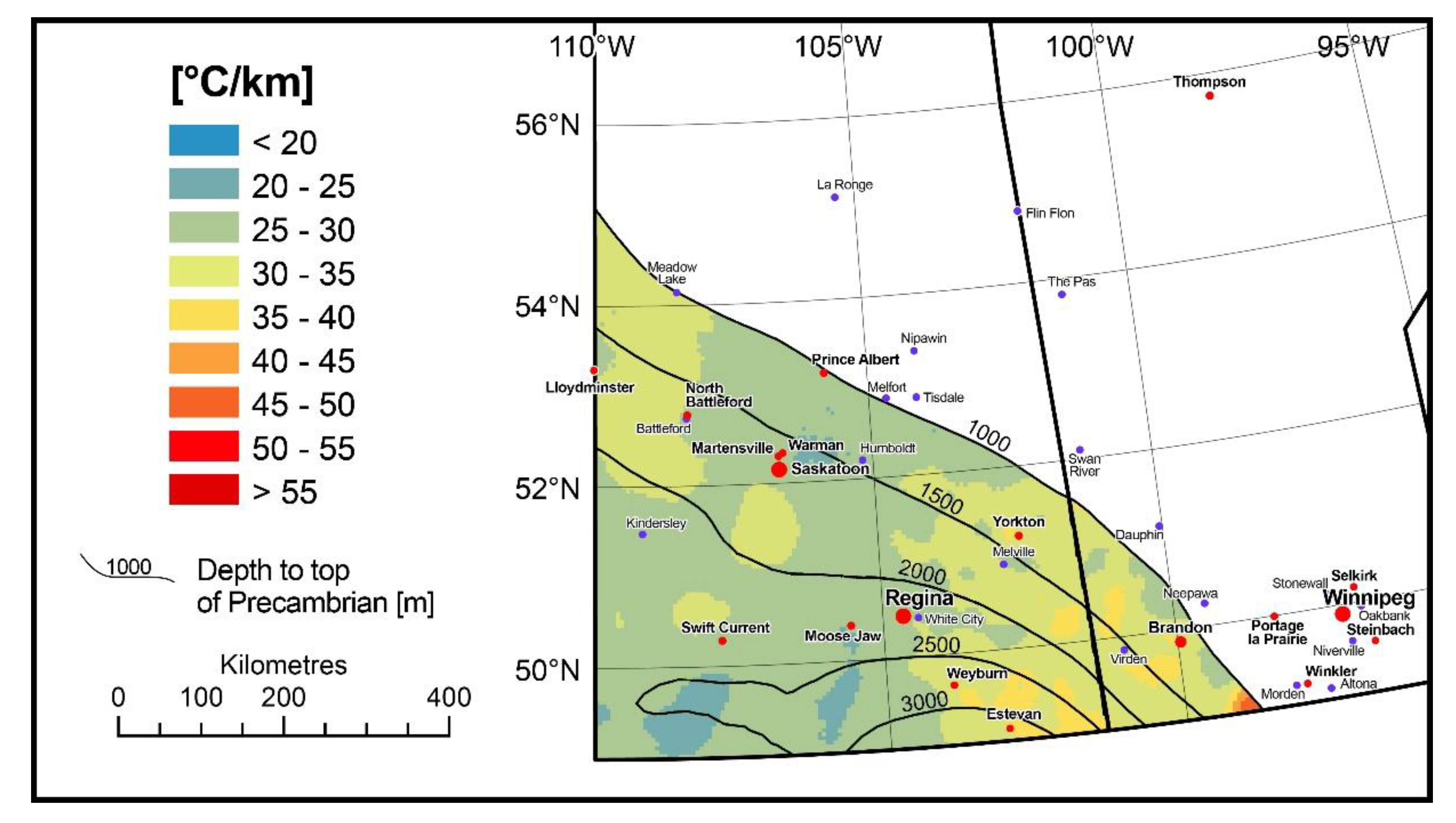
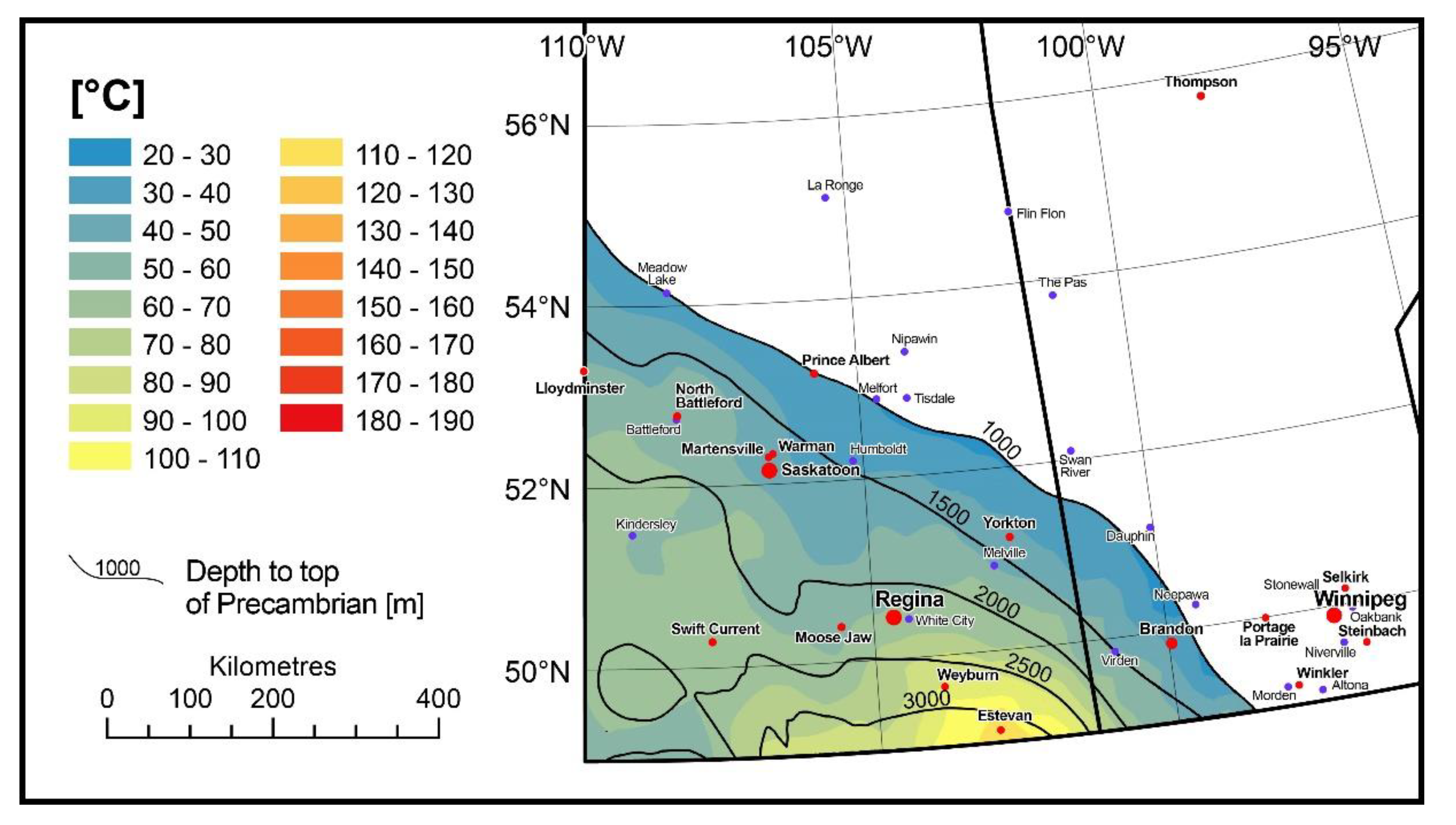
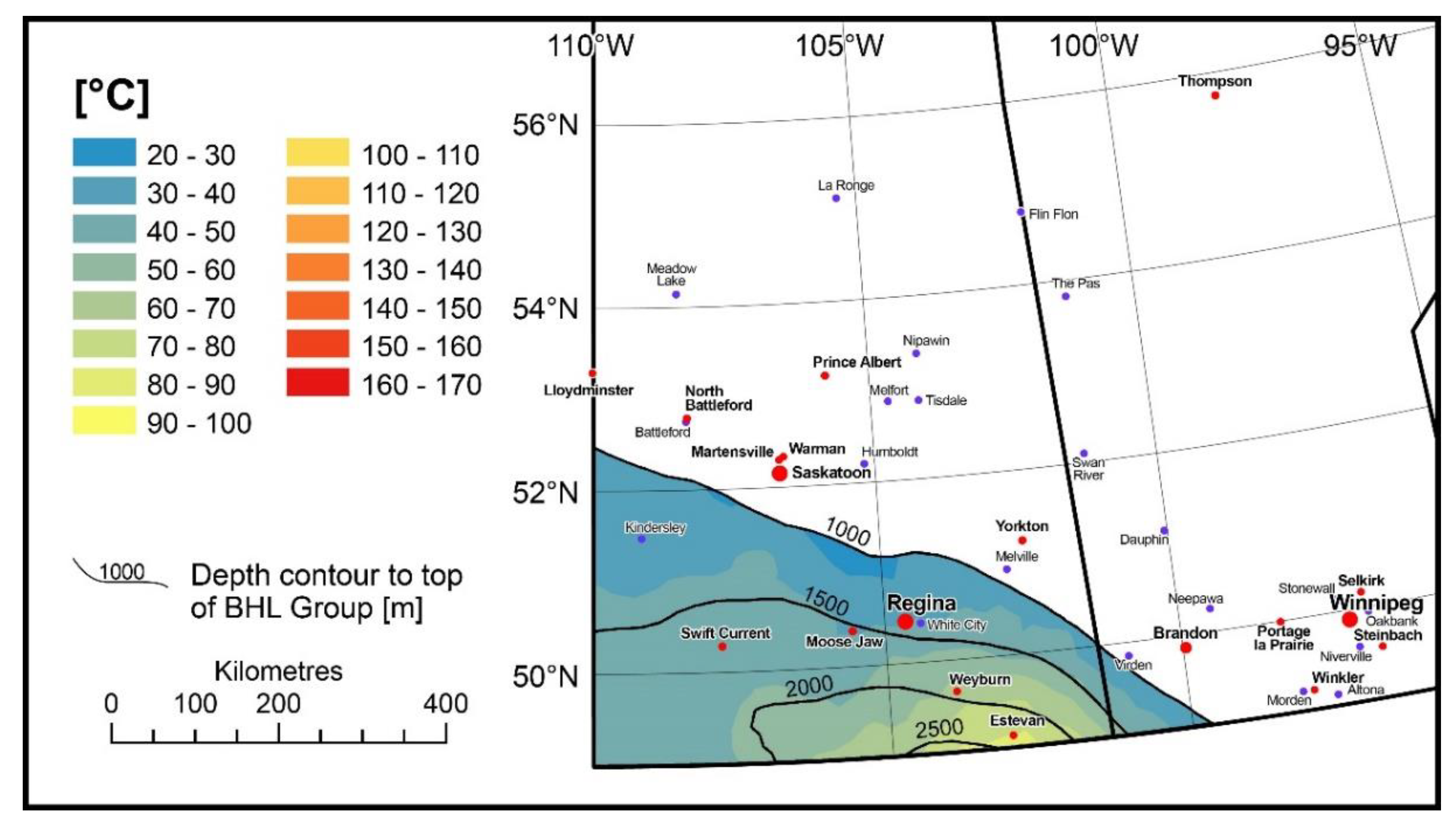
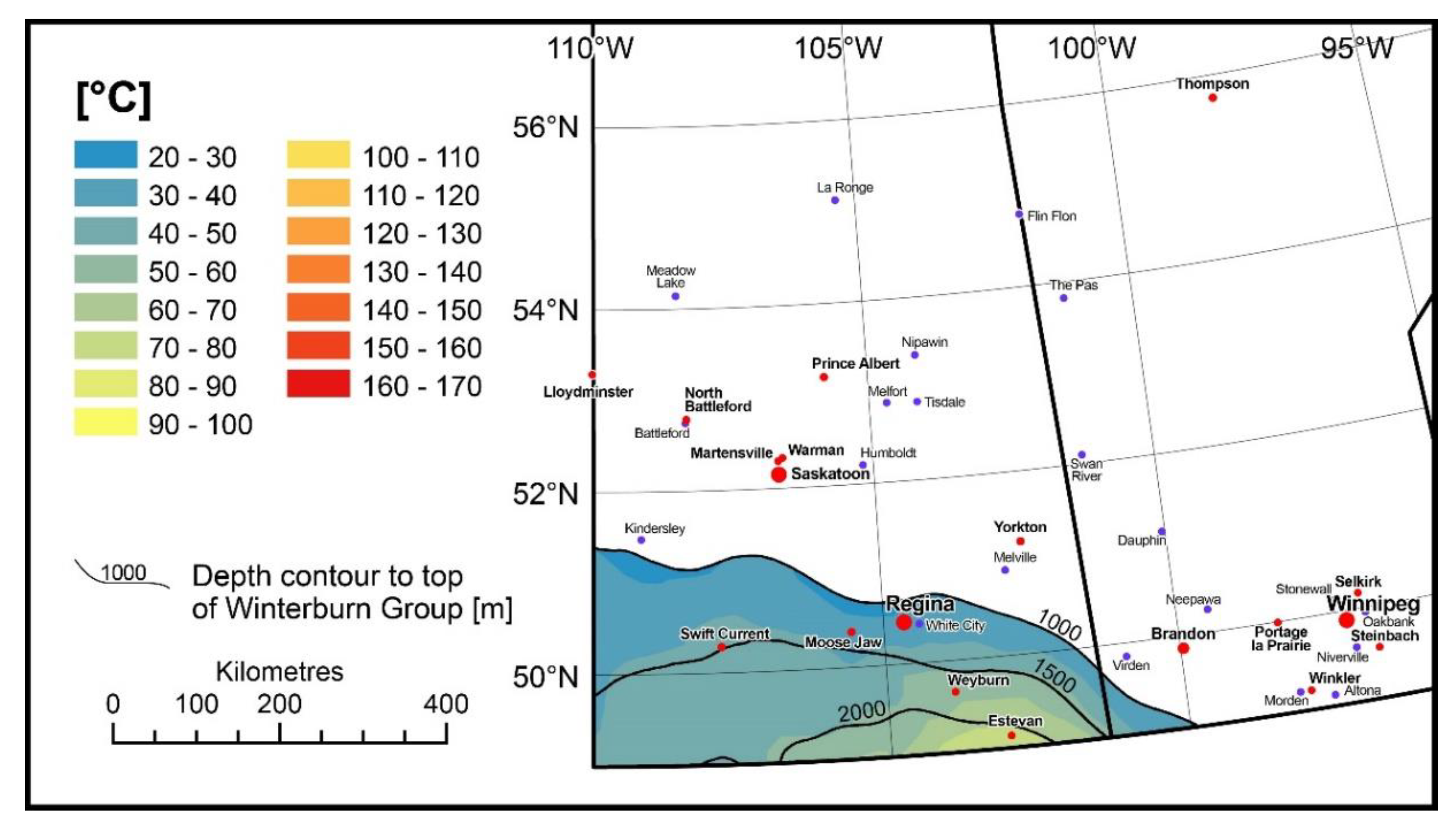

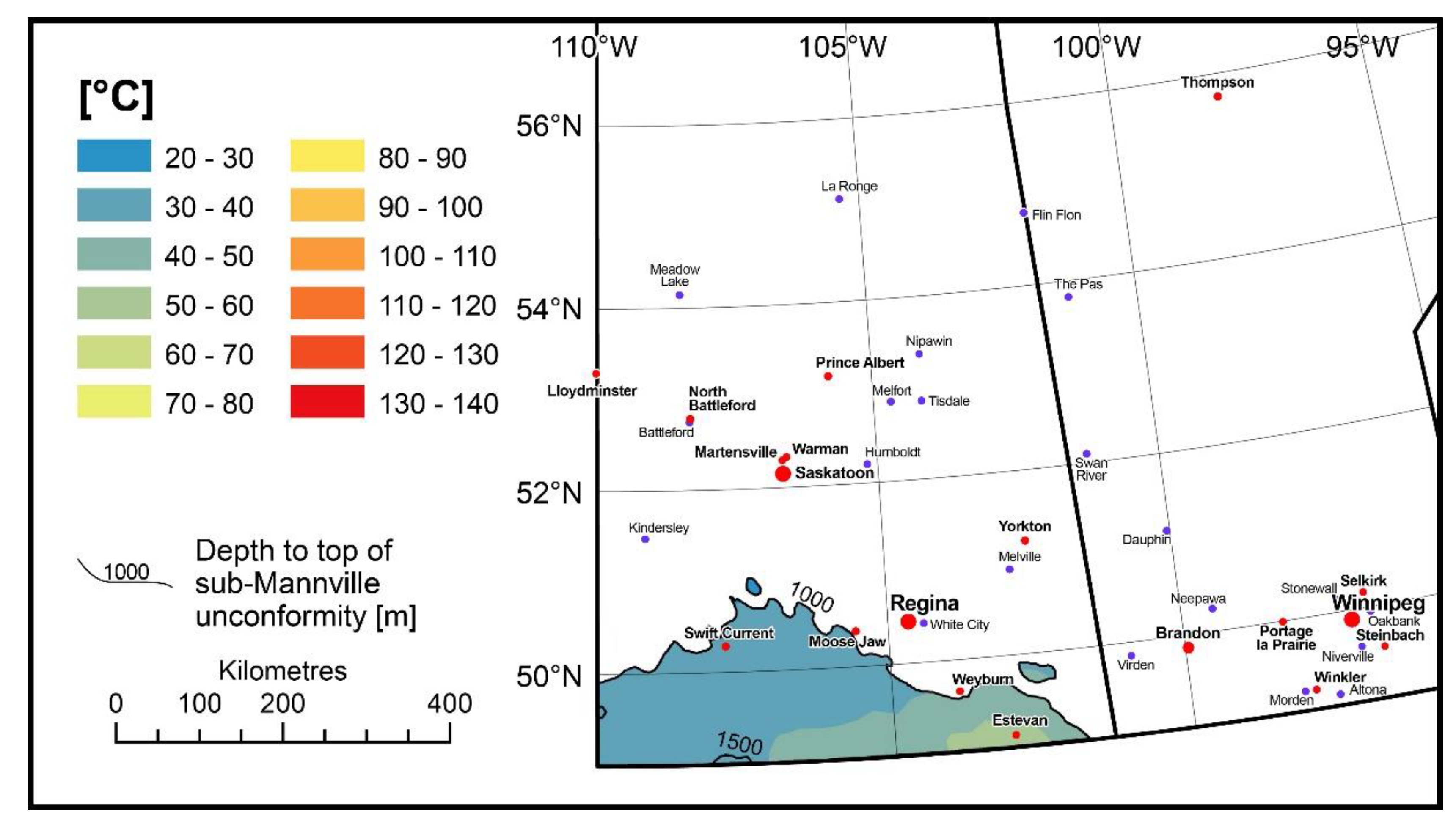
Appendix B
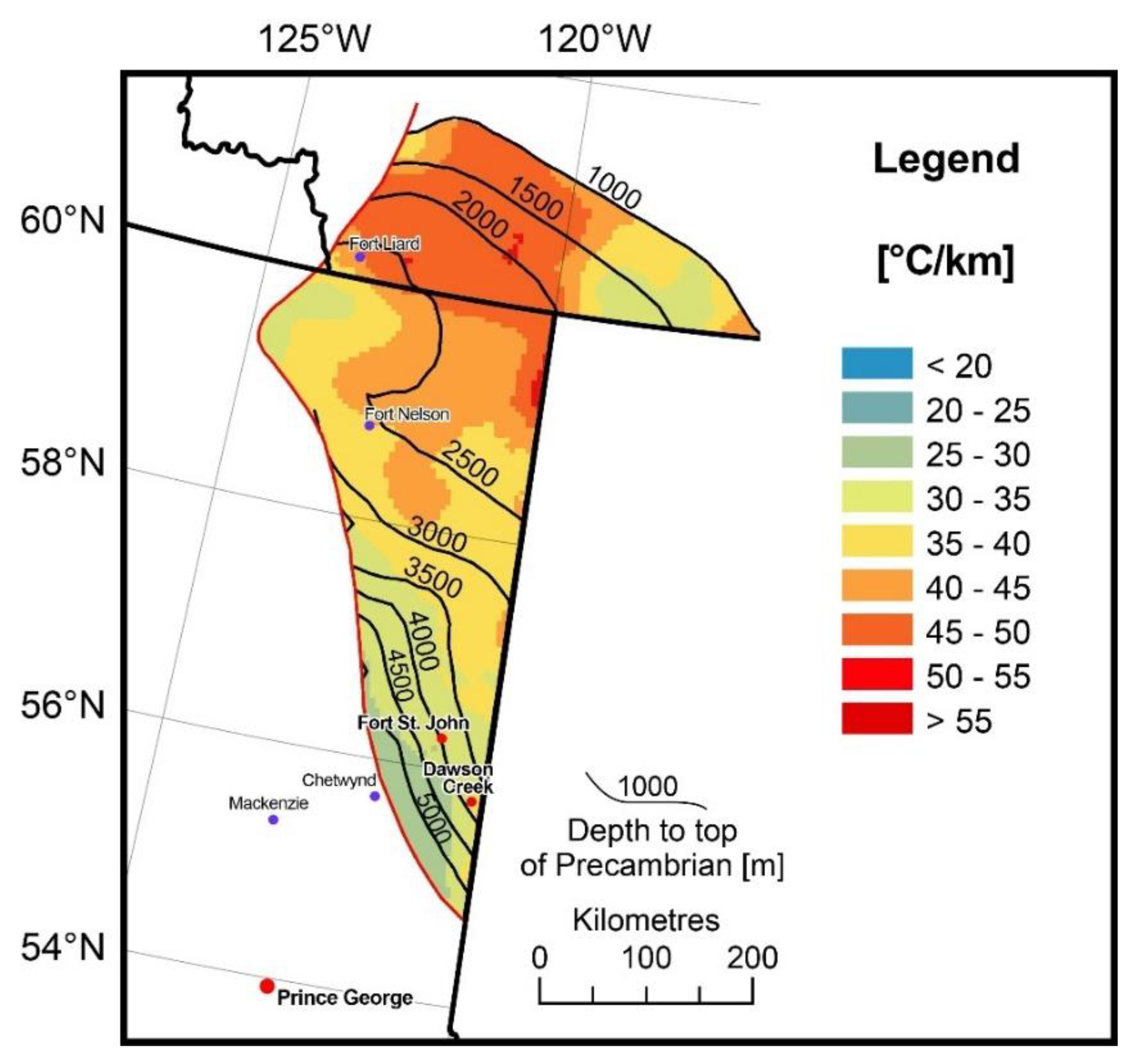
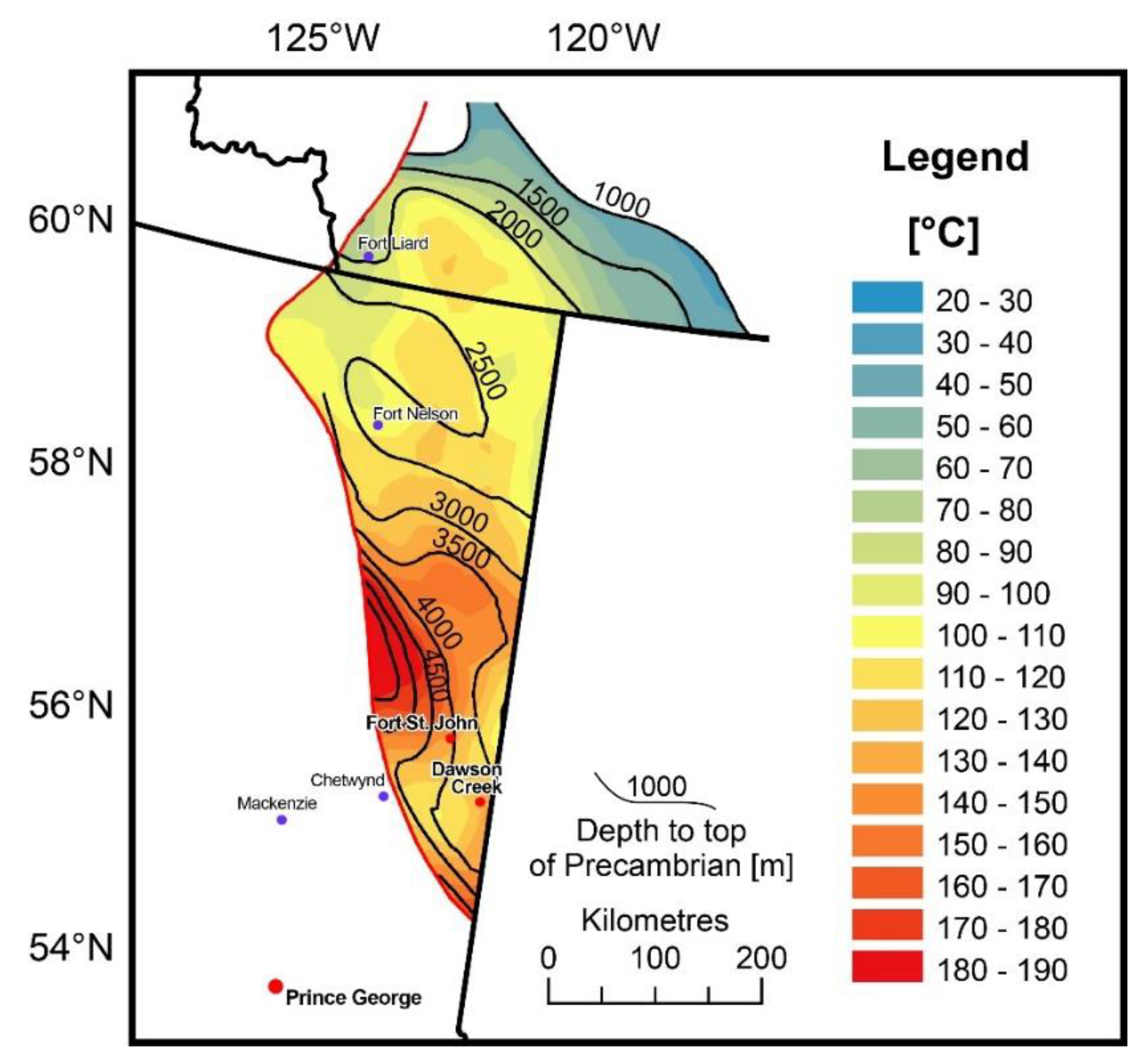
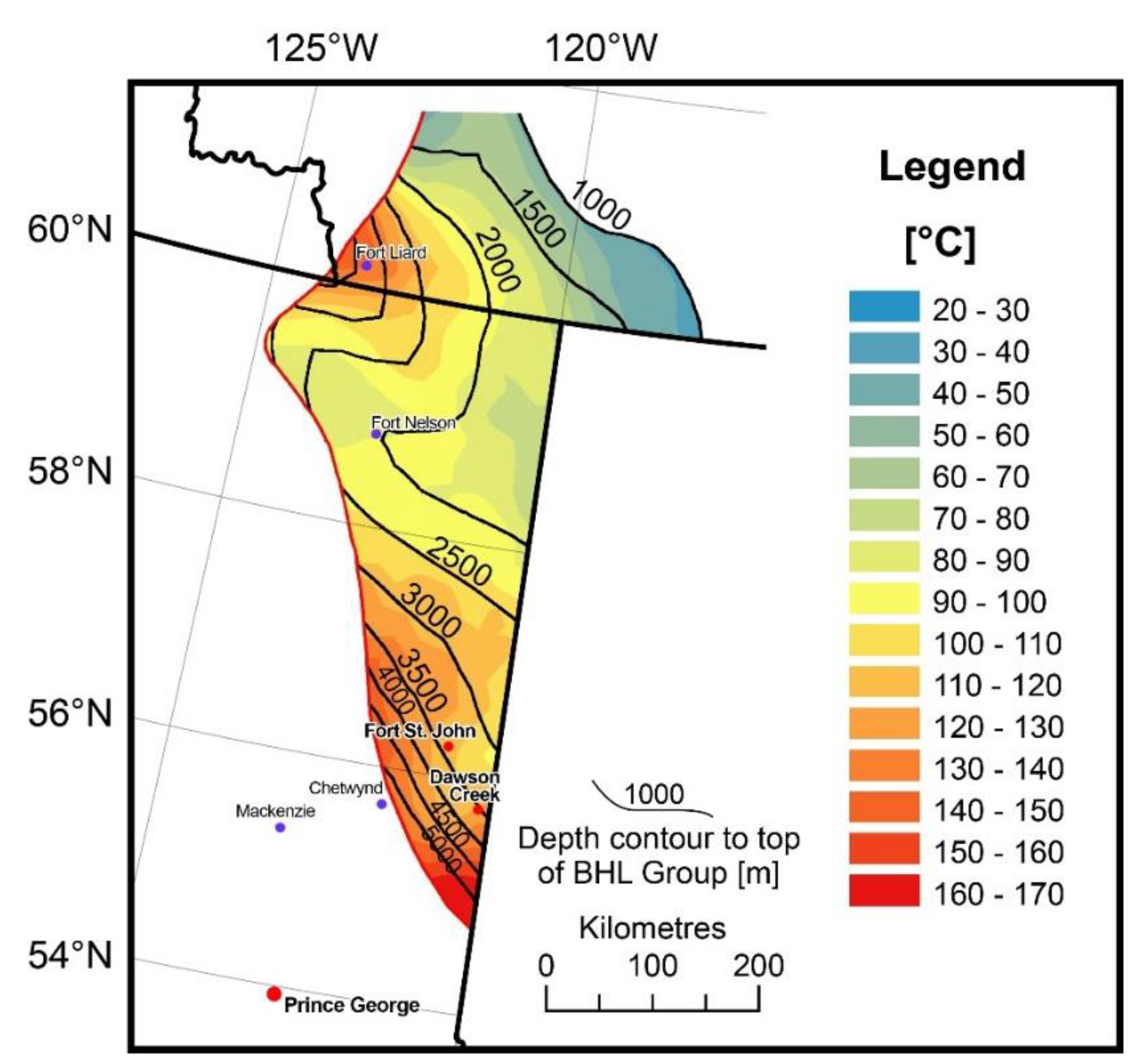
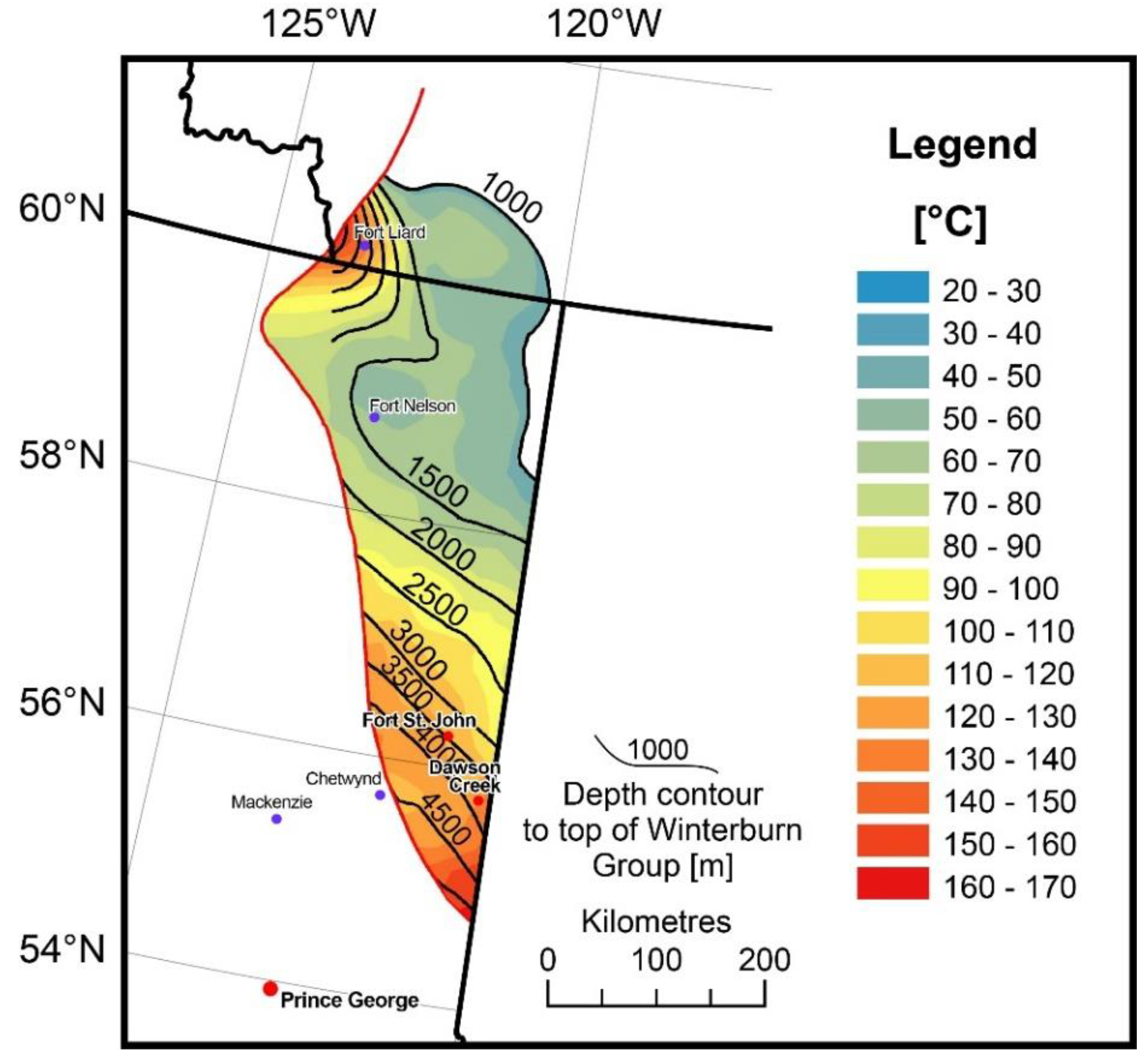
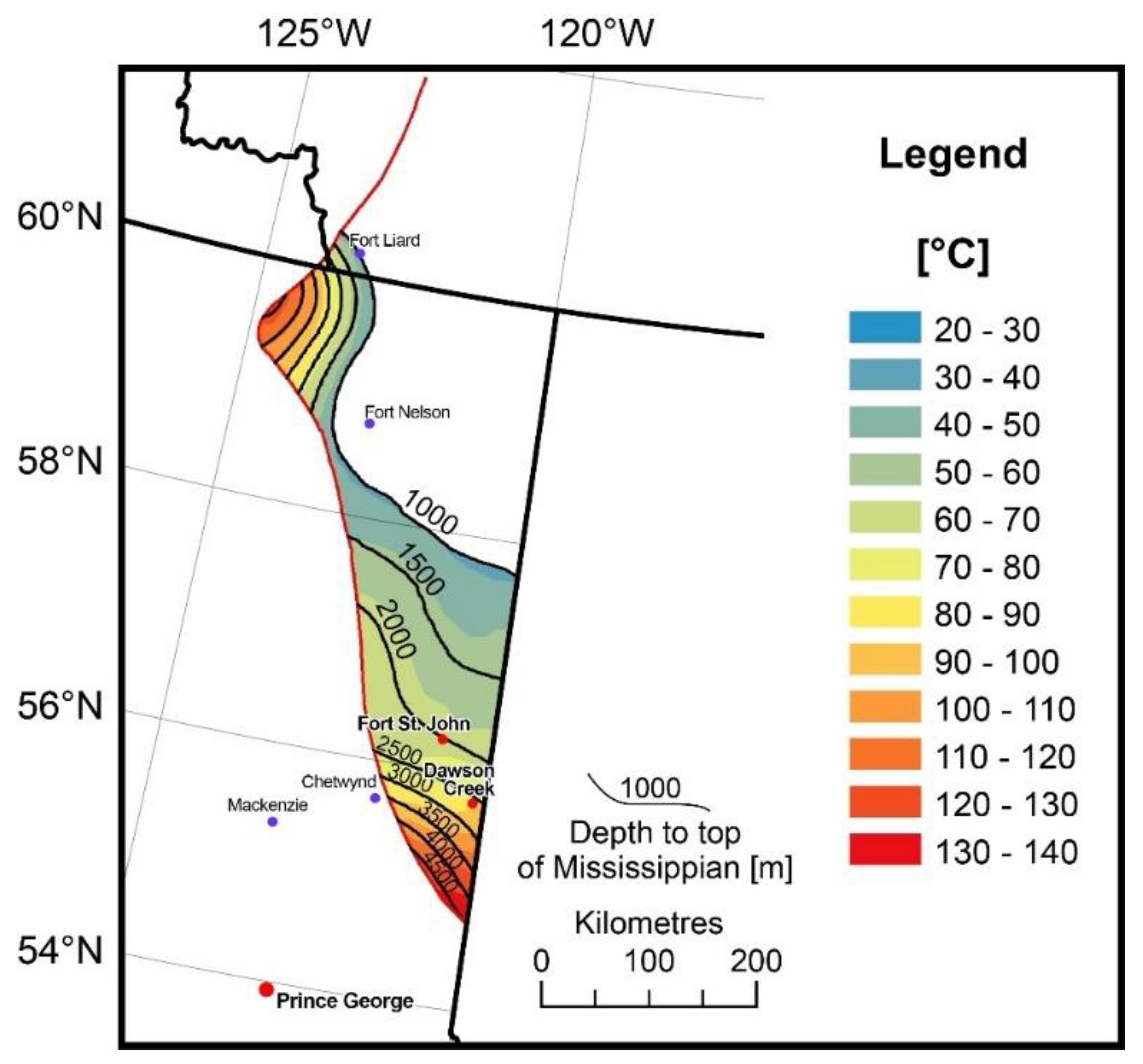
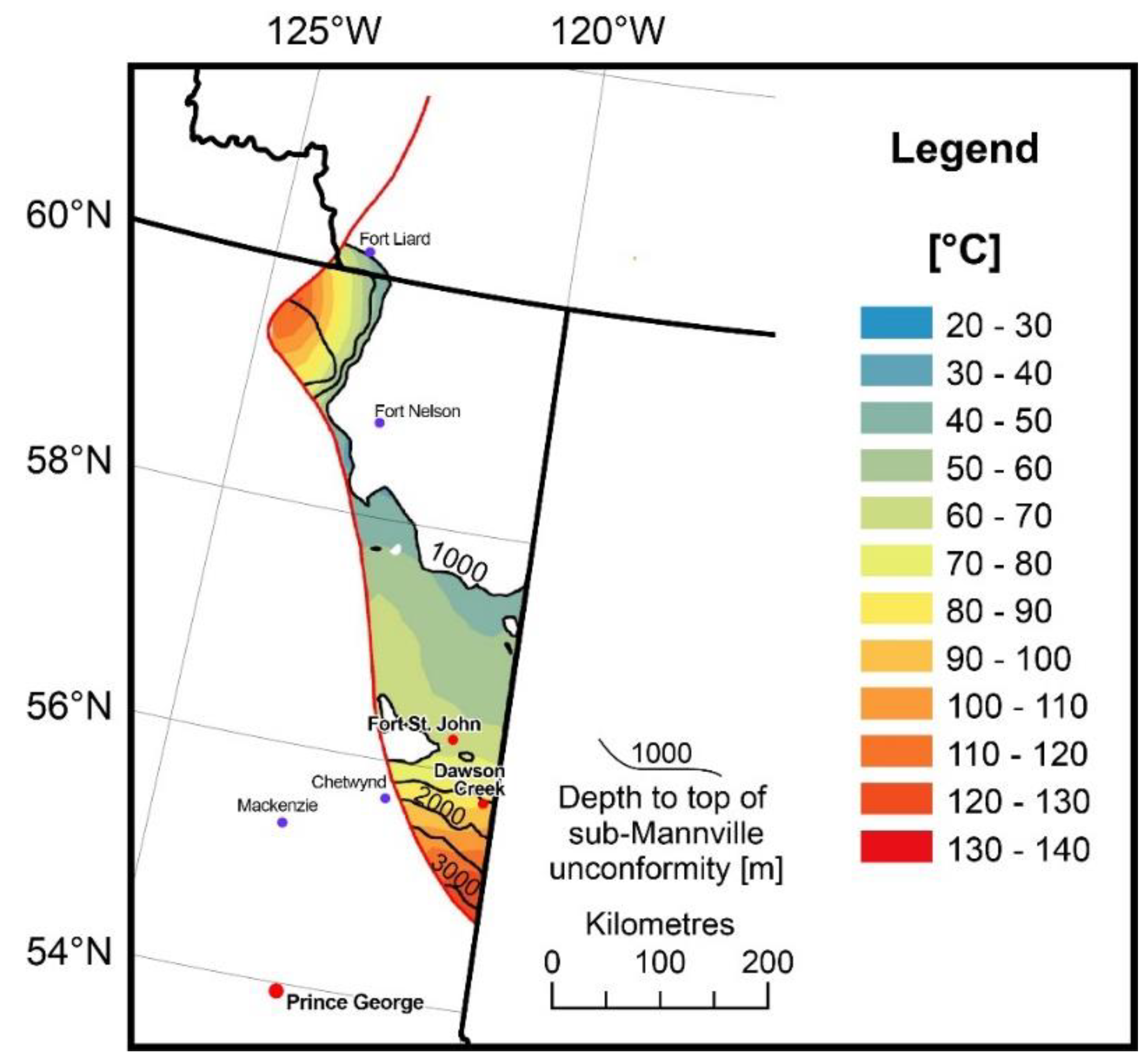
Appendix C
| City Location | Province | Temperature T | Energy 1 | Energy 2 | Energy 3 | Energy 4 | Households | Households | Power | Power | Enthalpy Gain | Formation Group | Depth |
|---|---|---|---|---|---|---|---|---|---|---|---|---|---|
| at C = 3993 | at C = 3150 | at C = 3993 | at C = 3150 | Minimum | Maximum | at C = 3993 | at C = 3150 | at C = 3993 | |||||
| at 30 kg/s | at 30 kg/s | at 80 kg/s | at 80 kg/s | number | number | at 30 kg/s | at 80 kg/s | ||||||
| Name | Name | °C | GJ Year | GJ Year | GJ Year | GJ Year | @ 130 GJ/Year | @ 130 GJ/Year | MW el. | MW el. | kJ/kg | km | |
| Airdrie | AB | 90 | 66,110 | 52,153 | 176,293 | 139,074 | 401 | 1356 | 0.5 | 0.8 | 280 | M. Cambrian Basal Sands. | 3.7 |
| Banff | AB | ? | _ | _ | _ | _ | _ | _ | _ | _ | _ | Disturbed belt | ? |
| Barrhead | AB | 83.2 | 51,125 | 40,331 | 136,333 | 107,550 | 310 | 1049 | 0.4 | 0.6 | 252 | M. Cambrian Basal Sands. | 2.6 |
| Battleford | Sask. | 51 | _ | _ | _ | _ | _ | _ | _ | _ | 124 | M. Cambrian Basal Sands. | 1.7 |
| Beaumont | AB | 90 | 66,110 | 52,153 | 176,293 | 139,074 | 401 | 1356 | 0.5 | 0.8 | 280 | M. Cambrian Basal Sands. | 2.6 |
| Blackfalds | AB | 120.25 | 132,770 | 104,740 | 354,054 | 279,306 | 806 | 2723 | 0.8 | 1.5 | 400 | M. Cambrian Basal Sands. | 3.25 |
| Bonnyville | AB | 49 | _ | _ | _ | _ | _ | _ | _ | _ | 116 | M. Cambrian Basal Sands. | 1.4 |
| Brooks | AB | 70 | 22,037 | 17,384 | 58,764 | 46,358 | 134 | 452 | 0.2 | 0.3 | 200 | M. Cambrian Basal Sands. | 2.4 |
| Calgary | AB | 100 | 88,146 | 69,537 | 235,057 | 185,432 | 535 | 1808 | 0.6 | 1.0 | 319 | M. Cambrian Basal Sands. | 3.8 |
| Camrose | AB | 80 | 44,073 | 34,768 | 117,528 | 92,716 | 267 | 904 | 0.4 | 0.5 | 240 | M. Cambrian Basal Sands. | 2.4 |
| Canmore | AB | 40 | _ | _ | _ | _ | _ | _ | _ | _ | 80 | RM Def. f. | _ |
| Cardston | AB | 70 | 22,037 | 17,384 | 58,764 | 46,358 | 134 | 452 | 0.2 | 0.3 | 200 | Disturbed belt fm | 3.5 |
| Carstairs | AB | 90 | 66,110 | 52,153 | 176,293 | 139,074 | 401 | 1356 | 0.5 | 0.8 | 280 | M. Cambrian Basal Sands. | 3.6 |
| Chestermere | AB | 90 | 66,110 | 52,153 | 176,293 | 139,074 | 401 | 1356 | 0.5 | 0.8 | 280 | M. Cambrian Basal Sands. | 3.7 |
| Claresholm | AB | 75.6 | 34,377 | 27,119 | 91,672 | 72,318 | 209 | 705 | 0.3 | 0.4 | 222 | M. Cambrian Basal Sands. | 3.6 |
| Coaldale | AB | 62.5 | 5509 | 4346 | 14,691 | 11,589 | 33 | 113 | 0.1 | 0.1 | 170 | M. Cambrian Basal Sands. | 2.5 |
| Cochrane | AB | 100 | 88,146 | 69,537 | 235,057 | 185,432 | 535 | 1808 | 0.6 | 1.0 | 319 | M. Cambrian Basal Sands. | 4.1 |
| Cold Lake | AB | 42 | _ | _ | _ | _ | _ | _ | _ | _ | 88 | M. Cambrian Basal Sands. | 1.2 |
| Cold Lake | AB | 40 | _ | _ | _ | _ | _ | _ | _ | _ | 80 | M. Cambrian Basal Sands. | 1.2 |
| Dawson Creek | NE BC | 137 | 168,580 | 132,989 | 449,546 | 354,638 | 1023 | 3458 | 1.0 | 1.9 | 465 | M. Cambrian Basal Sands. | 3.9 |
| Devon | AB | 99.9 | 87,926 | 69,363 | 234,469 | 184,968 | 534 | 1804 | 0.6 | 1.0 | 319 | M. Cambrian Basal Sands. | 2.7 |
| Didsbury | AB | 92.5 | 71,619 | 56,499 | 190,984 | 150,663 | 435 | 1469 | 0.5 | 0.8 | 289 | M. Cambrian Basal Sands. | 3.7 |
| Drayton Valley | AB | 119 | 130,016 | 102,567 | 346,709 | 273,512 | 789 | 2667 | 0.8 | 1.5 | 395 | M. Cambrian Basal Sands. | 3.4 |
| Drumheller | AB | 72.9 | 28,427 | 22,426 | 75,806 | 59,802 | 173 | 583 | 0.3 | 0.3 | 211 | M. Cambrian Basal Sands. | 2.7 |
| E. Lloydminster | Sask. | 51 | _ | _ | _ | _ | _ | _ | _ | _ | 124 | M. Cambrian Basal Sands. | 1.7 |
| Edmonton | AB | 90 | 66,110 | 52,153 | 176,293 | 139,074 | 401 | 1356 | 0.5 | 0.8 | 280 | M. Cambrian Basal Sands. | 2.5 |
| Edson | AB | 147 | 191,718 | 151,243 | 511,248 | 403,314 | 1163 | 3933 | 1.2 | 2.2 | 507 | M. Cambrian Basal Sands. | 4.2 |
| Estevan | Sask. | 115 | 121,642 | 95,961 | 324,378 | 255,896 | 738 | 2495 | 0.8 | 1.4 | 380 | U. Cambrian Deadwood | 3.2 |
| Fort Liard | NWT | 170 | 242,402 | 191,226 | 646,406 | 509,937 | 1471 | 4972 | 1.4 | 2.8 | 599 | M. Cambrian Basal Sands. | 4.25 |
| Fort Nelson | NE BC | 104 | 96,961 | 76,491 | 258,562 | 203,975 | 588 | 1989 | 0.6 | 1.1 | 335 | M. Cambrian Basal Sands. | 2.6 |
| Fort Sask. | AB | 90 | 66,110 | 52,153 | 176,293 | 139,074 | 401 | 1356 | 0.5 | 0.8 | 280 | M. Cambrian Basal Sands. | 2.4 |
| Fort St. John | NE BC | 128 | 149,849 | 118,213 | 399,596 | 315,234 | 909 | 3074 | 0.9 | 1.7 | 431 | M. Cambrian Basal Sands. | 4 |
| Grand Centre | AB | 40.5 | _ | _ | _ | _ | _ | _ | _ | _ | 82 | M. Cambrian Basal Sands. | 1.35 |
| Grande Cache | AB | ? | _ | _ | _ | _ | _ | _ | _ | _ | _ | Disturbed belt fm | ? |
| Grande Prairie | AB | 140 | 176,293 | 139,074 | 470,113 | 370,863 | 1070 | 3616 | 1.1 | 2.0 | 479 | Granite Wash | 3.7 |
| High River | AB | 100 | 88,146 | 69,537 | 235,057 | 185,432 | 535 | 1808 | 0.6 | 1.0 | 319 | M. Cambrian Basal Sands. | 4 |
| Hinton | AB | 170 | 242,402 | 191,226 | 646,406 | 509,937 | 1471 | 4972 | 1.4 | 2.8 | 599 | M. Cambrian Basal Sands. | 5.6 |
| Humboldt | Sask. | 35 | _ | _ | _ | _ | _ | _ | _ | _ | 60 | M. Cambrian Basal Sands. | 1.4 |
| Innisfail | AB | 87.5 | 60,601 | 47,807 | 161,602 | 127,484 | 368 | 1243 | 0.4 | 0.7 | 270 | M. Cambrian Basal Sands. | 3.5 |
| Jasper | AB | ? | _ | _ | _ | _ | _ | _ | _ | _ | _ | Disturbed belt | ? |
| Kindersley | Sask. | 59 | _ | _ | _ | _ | _ | _ | _ | _ | 157 | M. Cambrian Basal Sands. | 2.2 |
| Lacombe | AB | 120 | 132,219 | 104,305 | 352,585 | 278,148 | 802 | 2712 | 0.8 | 2.0 | 399 | M. Cambrian Basal Sands. | 3.2 |
| Langdon | AB | 80.5 | 45,175 | 35,638 | 120,467 | 95,034 | 274 | 927 | 0.4 | 0.5 | 242 | M. Cambrian Basal Sands. | 3.5 |
| Leduc | AB | 110 | 110,183 | 86,921 | 293,821 | 231,790 | 669 | 2260 | 0.7 | 2.0 | 359 | M. Cambrian Basal Sands. | 2.7 |
| Lethbridge | AB | 70 | 22,037 | 17,384 | 58,764 | 46,358 | 134 | 452 | 0.2 | 0.3 | 200 | M. Cambrian Basal Sands. | 2.7 |
| Lloydminster | AB | 50 | _ | _ | _ | _ | _ | _ | _ | _ | 120 | M. Cambrian Basal Sands. | 1.7 |
| Malville | Sask. | 48 | _ | _ | _ | _ | _ | _ | _ | _ | 112 | M. Cambrian Basal Sands. | 1.6 |
| Martensville | Sask. | 45 | _ | _ | _ | _ | _ | _ | _ | _ | 98 | M. Cambrian Basal Sands. | 1.65 |
| Meadow Lake | Sask. | 35 | _ | _ | _ | _ | _ | _ | _ | _ | 60 | M. Cambrian Basal Sands. | 1 |
| Medicine Hat | AB | 60 | _ | _ | _ | _ | _ | _ | 0.1 | _ | 160 | M. Cambrian Basal Sands. | 2.2 |
| Melford | Sask. | 30 | _ | _ | _ | _ | _ | _ | _ | _ | 40 | M. Cambrian Basal Sands. | 1 |
| Moose Jaw | Sask. | 55 | _ | _ | _ | _ | _ | _ | 0.1 | _ | 140 | M. Cambrian Basal Sands. | 2.2 |
| Morinville | AB | 100 | 88,146 | 69,537 | 235,057 | 185,432 | 535 | 1808 | 0.6 | 1.0 | 319 | M. Cambrian Basal Sands. | 2.4 |
| North Battleford | Sask. | 50 | _ | _ | _ | _ | _ | _ | _ | _ | 118 | M. Cambrian Basal Sands. | 1.65 |
| Olds | AB | 90 | 66,110 | 52,153 | 176,293 | 139,074 | 401 | 1356 | 0.5 | 0.8 | 280 | M. Cambrian Basal Sands. | 3.6 |
| Peace River | AB | 67.2 | 15,866 | 12,517 | 42,310 | 33,378 | 96 | 325 | 0.2 | 0.2 | 188 | Devonian Granite Wash | 2.1 |
| Penhold | AB | 95.2 | 77,569 | 61,192 | 206,850 | 163,180 | 471 | 1591 | 0.5 | 0.9 | 300 | M. Cambrian Basal Sands. | 3.4 |
| Pincher Creek | AB | 89.3 | 64,567 | 50,936 | 172,179 | 135,829 | 392 | 1324 | 0.5 | 0.7 | 277 | Disturbed belt fm | 4.7 |
| Ponoka | AB | 123 | 138,830 | 109,521 | 370,214 | 292,055 | 842 | 2848 | 0.9 | 1.6 | 411 | M. Cambrian Basal Sands. | 3 |
| Prince Albert | Sask. | 30 | _ | _ | _ | _ | _ | _ | _ | _ | 40 | M. Cambrian Basal Sands. | 1 |
| Raymond | AB | 57.5 | _ | _ | _ | _ | _ | _ | _ | _ | 150 | M. Cambrian Basal Sands. | 2.5 |
| Red Deer | AB | 115 | 121,201 | 95,613 | 323,203 | 254,969 | 735 | 2486 | 0.8 | 1.4 | 379 | M. Cambrian Basal Sands. | 3.3 |
| Redcliff | AB | 60.5 | 1102 | 869 | 2938 | 2318 | 7 | 23 | 0.1 | 0.0 | 162 | M. Cambrian Basal Sands. | 2.2 |
| Regina | Sask. | 61 | 1983 | 1565 | 5289 | 4172 | 12 | 41 | 0.1 | 0.0 | 163 | U. Cambrian Deadwood | 2.1 |
| Rocky Mountain House | AB | 144 | 185,107 | 146,027 | 493,619 | 389,407 | 1123 | 3797 | 1.1 | 2.1 | 495 | M. Cambrian Basal Sands. | 4.8 |
| Saskatoon | Sask. | 48 | _ | _ | _ | _ | _ | _ | _ | _ | 110 | M. Cambrian Basal Sands. | 1.7 |
| Slave Lake | AB | 73.5 | 29,749 | 23,469 | 79,332 | 62,583 | 181 | 610 | 0.3 | 0.3 | 214 | M. Cambrian Basal Sands. | 2.1 |
| Spruce Grove | AB | 90 | 66,110 | 52,153 | 176,293 | 139,074 | 401 | 1356 | 0.5 | 0.8 | 280 | M. Cambrian Basal Sands. | 2.6 |
| St. Albert | AB | 90 | 66,110 | 52,153 | 176,293 | 139,074 | 401 | 1356 | 0.5 | 0.8 | 280 | M. Cambrian Basal Sands. | 2.5 |
| St. Paul | AB | 55.25 | _ | _ | _ | _ | _ | _ | _ | _ | 141 | M. Cambrian Basal Sands. | 1.7 |
| Stettler | AB | 78.3 | 40,327 | 31,813 | 107,538 | 84,835 | 245 | 827 | 0.3 | 0.5 | 233 | M. Cambrian Basal Sands. | 2.7 |
| Stony Plain | AB | 90 | 66,110 | 52,153 | 176,293 | 139,074 | 401 | 1356 | 0.5 | 0.8 | 280 | M. Cambrian Basal Sands. | 2.6 |
| Swift Current | Sask. | 65 | 10,578 | 8344 | 28,207 | 22,252 | 64 | 217 | 0.2 | 0.1 | 179 | M. Cambrian Basal Sands. | 2.4 |
| Taber | AB | 59.4 | _ | _ | _ | _ | _ | _ | _ | _ | 157 | M. Cambrian Basal Sands. | 2.2 |
| Three Hills | AB | 80.6 | 45,395 | 35,811 | 121,054 | 95,497 | 275 | 931 | 0.4 | 0.5 | 242 | M. Cambrian Basal Sands. | 3.1 |
| Varman | Sask. | 43 | _ | _ | _ | _ | _ | _ | _ | _ | 93 | M. Cambrian Basal Sands. | 1.6 |
| Vegreville | AB | 64 | 8815 | 6954 | 23,506 | 18,543 | 53 | 181 | 0.2 | 0.1 | 176 | M. Cambrian Basal Sands. | 2 |
| Vermilion | AB | 55.8 | _ | _ | _ | _ | _ | _ | _ | _ | 143 | M. Cambrian Basal Sands. | 1.8 |
| Virden | Man. | 56 | _ | _ | _ | _ | _ | _ | _ | _ | 144 | M. Cambrian Basal Sands. | 1.6 |
| Wainwleft | AB | 64 | 8815 | 6954 | 23,506 | 18,543 | 53 | 181 | 0.2 | 0.1 | 176 | M. Cambrian Basal Sands. | 2 |
| Westlock | AB | 73.6 | 29,970 | 23,643 | 79,919 | 63,047 | 182 | 615 | 0.3 | 0.3 | 214 | M. Cambrian Basal Sands. | 2.3 |
| Wetaskiwin | AB | 110 | 110,183 | 86,921 | 293,821 | 231,790 | 669 | 2260 | 0.7 | 1.3 | 359 | M. Cambrian Basal Sands. | 2.7 |
| Weyburn | Sask. | 92 | 70,076 | 55,282 | 186,870 | 147,418 | 425 | 1437 | 0.5 | 0.8 | 287 | U. Cambrian Deadwood | 2.7 |
| White City | Sask. | 65 | 9916 | 7823 | 26,444 | 20,861 | 60 | 203 | 0.2 | 0.1 | 178 | U. Cambrian Deadwood | 2.15 |
| Whitecourt | AB | 140 | 176,293 | 139,074 | 470,113 | 370,863 | 1070 | 3616 | 1.1 | 2.0 | 479 | M. Cambrian Basal Sands. | 3.3 |
| Yorkton | Sask. | 46 | _ | _ | _ | _ | _ | _ | _ | _ | 102 | M. Cambrian Basal Sands. | 1.3 |
| City Location | Province | Temperature T | Energy 1 | Energy 2 | Energy 3 | Energy 4 | Households | Households | Power | Power | Enthalpy Gain | Formation Group | Depth |
|---|---|---|---|---|---|---|---|---|---|---|---|---|---|
| at C = 3993 | at C = 3150 | at C = 3993 | at C = 3150 | Minimum | Maximum | at C = 3993 | at C = 3150 | at C = 3993 | |||||
| at 30 kg/s | at 30 kg/s | at 80 kg/s | at 80 g/s | number | number | at 30 kg/s | at 80 kg/s | ||||||
| Name | Name | °C | GJ Year | GJ Year | GJ Year | GJ Year | @ 130 GJ/Year | @ 130 GJ/Year | MW el. | MW el. | kJ/kg | km | |
| Airdrie | AB | 80 | 44,073.14 | 34,768.44 | 117,528.4 | 92,715.84 | 267.4495 | 904.0643 | 0.35937 | 0.504 | 239.58 | /Leduc | 1.9 |
| Banff | AB | ? | _ | _ | _ | _ | _ | _ | _ | _ | Disturbed belt | ? | |
| Barrhead | AB | 59.2 | _ | _ | _ | _ | _ | _ | _ | _ | 156.5256 | U. Devonian Beaverhill L. | 1.85 |
| Battleford | Sask. | _ | _ | _ | _ | _ | _ | _ | _ | _ | _ | _ | _ |
| Beaumont | AB | 60 | _ | _ | _ | _ | _ | _ | _ | _ | 159.72 | Beaverhill l. Group | 1.7 |
| Blackfalds | AB | 85 | 55,091.42 | 43,460.55 | 146,910.5 | 115,894.8 | 334.3119 | 1130.08 | _ | 0.63 | 259.545 | U. Devonian Beaverhill L. | 2.5 |
| Bonnyville | AB | _ | _ | _ | _ | _ | _ | _ | _ | _ | _ | Shallow basin | |
| Brooks | AB | 50 | _ | _ | _ | _ | _ | _ | _ | _ | 119.79 | Beaverhill l. Group | 1.7 |
| Calgary | AB | 80 | 44,073.14 | 34,768.44 | 117,528.4 | 92,715.84 | 267.4495 | 904.0643 | 0.35937 | 0.504 | 239.58 | /Leduc | 3.4 |
| Camrose | AB | 60 | _ | _ | _ | _ | _ | _ | 0.11979 | _ | 159.72 | Beaverhill l. Group | 1.6 |
| Canmore | AB | _ | _ | _ | _ | _ | _ | _ | _ | _ | _ | Disturbed belt | _ |
| Cardston | AB | 66 | 13,221.94 | 10,430.53 | 35,258.51 | 27,814.75 | 80.23486 | 271.2193 | _ | _ | 183.678 | U. Devonian Beaverhill L. | 3.3 |
| Carstairs | AB | 75.6 | 34,377.05 | 27,119.38 | 91,672.12 | 72,318.36 | 208.6106 | 705.1702 | _ | _ | 222.0108 | Leduc F. | 3.15 |
| Chestermere | AB | 75 | 33,054.85 | 26,076.33 | 88,146.27 | 69,536.88 | 200.5872 | 678.0483 | _ | _ | 219.615 | /Leduc | 3 |
| Claresholm | AB | 70.35 | 22,807.85 | 17,992.67 | 60,820.93 | 47,980.45 | 138.4051 | 467.8533 | _ | _ | 201.0476 | U. Devonian Beaverhill L. | 3.35 |
| Coaldale | AB | 47.5 | _ | _ | _ | _ | _ | _ | _ | _ | 109.8075 | U. Devonian Beaverhill L. | 1.9 |
| Cochrane | AB | _ | _ | _ | _ | _ | _ | _ | _ | _ | _ | Disturbed belt | _ |
| Cold Lake | AB | _ | _ | _ | _ | _ | _ | _ | _ | _ | _ | Shallow basin | _ |
| Cold Lake | AB | _ | _ | _ | _ | _ | _ | _ | _ | _ | _ | Shallow basin | _ |
| Dawson Creek | NE BC | 126 | 145,441.4 | 114,735.9 | 387,843.6 | 30,5962.3 | 882.5835 | 2983.412 | 0.910404 | 1.6632 | 423.258 | U. Devonian Beaverhill L. | 3.6 |
| Devon | AB | 72.2 | 26,884.61 | 21,208.75 | 71,692.3 | 56,556.66 | 163.1442 | 551.4793 | _ | _ | 208.4346 | Cooking Lk F. | 1.9 |
| Didsbury | AB | 78.75 | 41,318.57 | 32,595.41 | 110,182.8 | 86,921.1 | 250.7339 | 847.5603 | _ | _ | 234.5888 | Leduc F. | 3.15 |
| Drayton Valley | AB | 86.8 | 59,058 | 46,589.71 | 157,488 | 124,239.2 | 358.3824 | 1211.446 | _ | 0.67536 | 266.7324 | U. Devonian Beaverhill L. | 2.8 |
| Drumheller | AB | 51.3 | _ | _ | _ | _ | _ | _ | _ | _ | 124.9809 | Leduc F. | 1.9 |
| E.Lloydminster | Sask. | _ | _ | _ | _ | _ | _ | _ | _ | _ | _ | _ | _ |
| Edmonton | AB | 70 | 22,036.57 | 17,384.22 | 58,764.18 | 46,357.92 | 133.7248 | 452.0322 | _ | _ | 199.65 | Beaverhill l. Group | 1.7 |
| Edson | AB | 126 | 145,441.4 | 114,735.9 | 387,843.6 | 30,5962.3 | 882.5835 | 2983.412 | 0.910404 | 1.6632 | 423.258 | Beaverhill l. Group | 3.6 |
| Estevan | Sask. | 82.8 | 50,243.38 | 39,636.02 | 133,982.3 | 105,696.1 | 304.8925 | 1030.633 | 0.392911 | 0.57456 | 250.7604 | U. Devonian Beaverhill L. | 2.3 |
| Fort Liard | NWT | 136 | 167,477.9 | 132,120.1 | 446,607.8 | 352,320.2 | 1016.308 | 3435.445 | 1.030194 | 1.9152 | 463.188 | U. Devonian Beaverhill L. | 3.4 |
| Fort Nelson | NE BC | 84 | 52,887.76 | 41,722.13 | 141,034 | 111,259 | 320.9394 | 1084.877 | _ | 0.6048 | 255.552 | U. Devonian Beaverhill L. | 2.1 |
| Fort Sask. | AB | 60 | _ | _ | _ | _ | _ | _ | _ | _ | 159.72 | Beaverhill l. Group | 1.6 |
| Fort St. John | NE BC | 112 | 114,590.2 | 90,397.94 | 305,573.7 | 241,061.2 | 695.3688 | 2350.567 | 0.742698 | 1.3104 | 367.356 | U. Devonian Beaverhill L. | 3.5 |
| Grand Centre | AB | _ | _ | _ | _ | _ | _ | _ | _ | Shallow basin | _ | ||
| Grande Cache | AB | _ | _ | _ | _ | _ | _ | _ | _ | Disturbed belt | _ | ||
| Grande Prairie | AB | 90 | 66,109.71 | 52,152.66 | 176,292.5 | 139,073.8 | 401.1743 | 1356.097 | 0.47916 | 0.756 | 279.51 | /Leduc | 3.5 |
| High River | AB | 80 | 44,073.14 | 34,768.44 | 117,528.4 | 92,715.84 | 267.4495 | 904.0643 | 0.35937 | 0.504 | 239.58 | Beaverhill l. Group | 3.5 |
| Hinton | AB | 160 | 220,365.7 | 173,842.2 | 587,641.8 | 463,579.2 | 1337.248 | 4520.322 | 1.31769 | 2.52 | 559.02 | /Leduc | 3.4−5.4 |
| Humboldt | Sask. | _ | _ | _ | _ | _ | _ | _ | _ | _ | _ | _ | _ |
| Innisfail | AB | 68.75 | 19,282 | 15,211.19 | 51,418.66 | 40,563.18 | 117.0092 | 395.5282 | _ | _ | 194.6588 | U. Devonian Beaverhill L. | 2.75 |
| Jasper | AB | _ | _ | _ | _ | _ | _ | _ | _ | _ | _ | Disturbed belt | |
| Kindersley | Sask. | 32.4 | _ | _ | _ | _ | _ | _ | _ | _ | 49.5132 | U. Devonian Beaverhill L. | 1.2 |
| Lacombe | AB | 130 | 154,256 | 121,689.5 | 411,349.3 | 324,505.4 | 936.0734 | 3164.225 | 0.95832 | 1.764 | 439.23 | Beaverhill l. Group | 2.3 |
| Langdon | AB | 69.6 | 21,155.11 | 16,688.85 | 56,413.62 | 44,503.6 | 128.3758 | 433.9509 | _ | _ | 198.0528 | Leduc F. | 2.9 |
| Leduc | AB | 80 | 44,073.14 | 34,768.44 | 117,528.4 | 92,715.84 | 267.4495 | 904.0643 | _ | 0.504 | 239.58 | Beaverhill l. Group | 1.9 |
| Lethbridge | AB | 60 | _ | _ | _ | _ | _ | _ | _ | _ | 159.72 | Beaverhill l. Group | 2.3 |
| Lloydminster | AB | _ | _ | _ | _ | _ | _ | _ | _ | _ | _ | Shallow basin | _ |
| Malville | Sask. | _ | _ | _ | _ | _ | _ | _ | _ | _ | _ | Shallow basin | _ |
| Martensville | Sask. | _ | _ | _ | _ | _ | _ | _ | _ | _ | _ | Shallow basin | _ |
| Meadow Lake | Sask. | _ | _ | _ | _ | _ | _ | _ | _ | _ | _ | Shallow basin | _ |
| Medicine Hat | AB | 50 | _ | _ | _ | _ | _ | _ | _ | _ | 119.79 | Beaverhill l. Group | 1.6 |
| Melford | Sask. | _ | _ | _ | _ | _ | _ | _ | _ | _ | _ | _ | _ |
| Moose Jaw | Sask. | 37.5 | _ | _ | _ | _ | _ | _ | _ | _ | 69.8775 | U. Devonian Beaverhill L. | 1.5 |
| Morinville | AB | 70 | 22,036.57 | 17,384.22 | 58,764.18 | 46,357.92 | 133.7248 | 452.0322 | _ | _ | 199.65 | /Cooking Lk F. | 1.6 |
| North Battleford | Sask. | _ | _ | _ | _ | _ | _ | _ | _ | _ | _ | Shallow basin | _ |
| Olds | AB | 76.25 | 35,809.42 | 28,249.36 | 95,491.8 | 75,331.62 | 217.3028 | 734.5523 | _ | _ | 224.6063 | Leduc F. | 3.05 |
| Peace River | AB | 67.2 | 15,866.33 | 12,516.64 | 42,310.21 | 33,377.7 | 96.28183 | 325.4632 | _ | _ | 188.4696 | Leduc F. | 2.1 |
| Penhold | AB | 70.2 | 22,477.3 | 17,731.9 | 59,939.47 | 47,285.08 | 136.3993 | 461.0728 | _ | _ | 200.4486 | U. Devonian Beaverhill L. | 2.6 |
| Pincher Creek | AB | _ | _ | _ | _ | _ | _ | _ | _ | _ | Disturbed belt | _ | |
| Ponoka | AB | 88 | 61,702.39 | 48,675.82 | 164,539.7 | 129,802.2 | 374.4294 | 1265.69 | _ | 0.7056 | 271.524 | U. Devonian Beaverhill L. | 2.2 |
| Prince Albert | Sask. | _ | _ | _ | _ | _ | _ | _ | _ | _ | _ | Shallow basin | _ |
| Raymond | AB | _ | 111.804 | U. Devonian Beaverhill L. | 2 | ||||||||
| Red Deer | AB | 90 | 66,109.71 | 52,152.66 | 176,292.5 | 139,073.8 | 401.1743 | 1356.097 | _ | 0.756 | 279.51 | /Leduc F. to SE | 2.6 |
| Redcliff | AB | 45.375 | _ | _ | _ | _ | _ | _ | _ | _ | 101.3224 | U. Devonian Beaverhill L. | 1.65 |
| Regina | Sask. | 42 | _ | _ | _ | _ | _ | _ | _ | _ | 87.846 | U. Devonian Beaverhill L. | 1.4 |
| Rocky Mountain House | AB | 108.5 | 106,877.4 | 84,313.47 | 285,006.3 | 224,835.9 | 648.5651 | 2192.356 | 0.700772 | 1.2222 | 353.3805 | U. Devonian Beaverhill L. | 3.5 |
| Saskatoon | Sask. | _ | _ | _ | _ | _ | _ | _ | _ | _ | _ | Shallow basin | _ |
| Slave Lake | AB | 54.4 | _ | _ | _ | _ | _ | _ | _ | _ | 137.3592 | U. Devonian Beaverhill L. | 1.6 |
| Spruce Grove | AB | 70 | 22,036.57 | 17,384.22 | 58,764.18 | 46,357.92 | 133.7248 | 452.0322 | _ | _ | 199.65 | Beaverhill l. Group | 1.9 |
| St. Albert | AB | 60 | _ | _ | _ | _ | _ | _ | _ | _ | 159.72 | /Cooking Lk F. | 1.7 |
| St. Paul | AB | _ | _ | _ | _ | _ | _ | _ | _ | −79.86 | Shallow basin | _ | |
| Stettler | AB | 55.5 | _ | _ | _ | _ | _ | _ | _ | _ | 141.7515 | Leduc F. | 1.85 |
| Stony Plain | AB | 70 | 22,036.57 | 17,384.22 | 58,764.18 | 46,357.92 | 133.7248 | 452.0322 | _ | _ | 199.65 | Beaverhill l. Group | 2 |
| Swift Current | Sask. | 45.9 | _ | _ | _ | _ | _ | _ | _ | _ | 103.4187 | U. Devonian Beaverhill L. | 1.7 |
| Taber | AB | 45.9 | _ | _ | _ | _ | _ | _ | _ | _ | 103.4187 | U. Devonian Beaverhill L. | 1.7 |
| Three Hills | AB | 59.8 | _ | _ | _ | _ | _ | _ | _ | _ | 158.9214 | U. Devonian Beaverhill L. | 2.3 |
| Varman | Sask. | _ | _ | _ | _ | _ | _ | _ | _ | _ | _ | Shallow basin | _ |
| Vegreville | AB | 35.2 | _ | _ | _ | _ | _ | _ | _ | _ | 60.6936 | U. Devonian Beaverhill L. | 1.1 |
| Vermilion | AB | _ | _ | _ | _ | _ | _ | _ | _ | _ | Shallow basin | _ | |
| Virden Man. | Man. | _ | _ | _ | _ | _ | _ | _ | _ | _ | _ | Shallow basin | _ |
| Wainwright | AB | 33.6 | _ | _ | _ | _ | _ | _ | _ | _ | 54.3048 | U. Devonian Beaverhill L. | 1.05 |
| Westlock | AB | 51.2 | _ | _ | _ | _ | _ | _ | _ | _ | 124.5816 | U. Devonian Beaverhill L. | 1.6 |
| Wetaskiwin | AB | 80 | 44,073.14 | 34,768.44 | 117,528.4 | 92,715.84 | 267.4495 | 904.0643 | _ | _ | 239.58 | Beaverhill l. Group | 2 |
| Weyburn | Sask. | 66.3 | 13,883.04 | 10,952.06 | 37,021.43 | 29,205.49 | 84.2466 | 284.7803 | _ | _ | 184.8759 | U. Devonian Beaverhill L. | 1.95 |
| White City | Sask. | 42 | _ | _ | _ | _ | _ | _ | _ | _ | 87.846 | U. Devonian Beaverhill L. | 1.4 |
| Whitecourt | AB | 110 | 110,182.8 | 86,921.1 | 293,820.9 | 231,789.6 | 668.6238 | 2260.161 | 0.71874 | 1.26 | 359.37 | Swan H. - Slave Pt | 2.7 |
| Yorkton | Sask. | _ | _ | _ | _ | _ | _ | _ | _ | _ | _ | Shallow basin | _ |
| City Location | Province | Temperature T | Energy 1 | Energy 2 | Energy 3 | Energy 4 | Households | Households | Power | Power | Enthalpy Gain | Formation Group | Depth |
|---|---|---|---|---|---|---|---|---|---|---|---|---|---|
| at C = 3993 | at C = 3150 | at C = 3993 | at C = 3150 | Minimum | Maximum | at C = 3993 | at C = 3150 | at C = 3993 | top of Winterburn Group | ||||
| at 30 kg/s | at 30 kg/s | at 80 kg/s | at 80 kg/s | number | number | at 30 kg/s | at 80 kg/s | ||||||
| Name | Name | °C | GJ Year | GJ Year | GJ Year | GJ Year | @ 130 GJ/Year | @ 130 GJ/Year | MW el. | MW el. | kJ/kg | km | |
| Airdrie | AB | 70 | 22,036.57 | 17,384.22 | 58,764.18 | 46,357.92 | 133.7248 | 452.0322 | 0.23958 | 0.252 | 199.65 | /Dolomite Nisku | 2.9 |
| Banff | AB | _ | _ | _ | _ | _ | _ | _ | _ | _ | _ | Disturbed belt | _ |
| Barrhead | AB | 44.8 | _ | _ | _ | _ | _ | _ | _ | _ | 99.0264 | Wabamum dolomite | 1.4 |
| Battleford | Sask. | _ | _ | _ | _ | _ | _ | _ | _ | _ | _ | Shallow basin | _ |
| Beaumont | AB | 50 | _ | _ | _ | _ | _ | _ | _ | _ | 119.79 | Wabamum dolomite | 1.3 |
| Blackfalds | AB | 73.1 | 28,867.9 | 22,773.33 | 76,981.08 | 60,728.88 | 175.1794 | 592.1621 | 0.276715 | 0.33012 | 212.0283 | Dolomite Nisku | 2.15 |
| Bonnyville | AB | _ | _ | _ | _ | _ | _ | _ | _ | _ | _ | Shallow basin | _ |
| Brooks | AB | 40 | _ | _ | _ | _ | _ | _ | _ | _ | 79.86 | Winterburn/Wabamun | 1.4 |
| Calgary | AB | 70 | 22,036.57 | 17,384.22 | 58,764.18 | 46,357.92 | 133.7248 | 452.0322 | 0.23958 | 0.252 | 199.65 | /Dolomite Nisku | 3 |
| Camrose | AB | 50 | _ | _ | _ | _ | _ | _ | _ | _ | 119.79 | /Dolomite Nisku | 1.3 |
| Canmore | AB | _ | _ | _ | _ | _ | _ | _ | _ | _ | _ | Shallow basin | _ |
| Cardston | AB | 60 | _ | _ | _ | _ | _ | _ | _ | _ | 159.72 | top of Winterburn Group | 3 |
| Carstairs | AB | 68.4 | 18,510.72 | 14,602.74 | 49,361.91 | 38,940.65 | 112.3288 | 379.707 | 0.220414 | 0.21168 | 193.2612 | Dolimite Nisku | 2.85 |
| Chestermere | AB | 70 | 22,036.57 | 17,384.22 | 58,764.18 | 46,357.92 | 133.7248 | 452.0322 | 0.23958 | 0.252 | 199.65 | /Dolomite Nisku | 2.8 |
| Claresholm | AB | 60.9 | 1983.291 | 1564.58 | 5288.776 | 4172.213 | 12.03523 | 40.6829 | 0.130571 | 0.02268 | 163.3137 | top of Winterburn Group | 2.9 |
| Coaldale | AB | _ | _ | _ | _ | _ | _ | _ | _ | _ | 79.86 | top of Winterburn Group | 1.6 |
| Cochrane | AB | _ | _ | _ | _ | _ | _ | _ | _ | _ | _ | Shallow basin | _ |
| Cold Lake | AB | Shallow basin | _ | ||||||||||
| Cold Lake | AB | _ | _ | _ | _ | _ | _ | _ | _ | _ | _ | Shallow basin | _ |
| Dawson Creek | NE BC | 131.25 | 157,010.5 | 123,862.6 | 418,694.8 | 330,300.2 | 952.789 | 3220.729 | 0.973294 | 1.7955 | 444.2213 | top of Winterburn Group | 3.75 |
| Devon | AB | 57 | 147.741 | Wabamum dolomite | 1.5 | ||||||||
| Didsbury | AB | 70 | 22,036.57 | 17,384.22 | 58,764.18 | 46,357.92 | 133.7248 | 452.0322 | 0.23958 | 0.252 | 199.65 | Dolomite Nisku | 2.8 |
| Drayton Valley | AB | 72 | 26,443.88 | 20,861.06 | 70,517.02 | 55,629.5 | 160.4697 | 542.4386 | 0.263538 | 0.3024 | 207.636 | Wabamum dolomite | 2.4 |
| Drumheller | AB | 45.9 | _ | _ | _ | _ | _ | _ | _ | _ | 103.4187 | Dolomite Nisku | 1.7 |
| E.Lloydminster | Sask. | 0 | _ | _ | _ | _ | _ | _ | _ | _ | _ | Shallow basin | _ |
| Edmonton | AB | 50 | _ | _ | _ | _ | _ | _ | _ | _ | 119.79 | /Dolomite Nisku | 1.2 |
| Edson | AB | 112 | 114,590.2 | 90,397.94 | 305,573.7 | 241,061.2 | 695.3688 | 2350.567 | 0.742698 | 1.3104 | 367.356 | top of Winterburn Group | 3.2 |
| Estevan | Sask. | 77.4 | 38,343.63 | 30,248.54 | 102,249.7 | 80,662.78 | 232.6811 | 786.536 | 0.328225 | 0.43848 | 229.1982 | top of Winterburn Group | 2.15 |
| Fort Liard | NWT | 132 | 158,663.3 | 125,166.4 | 423,102.1 | 333,777 | 962.8183 | 3254.632 | 0.982278 | 1.8144 | 447.216 | top of Winterburn Group | 3.3 |
| Fort Nelson | NE BC | 56 | _ | _ | _ | _ | _ | _ | 0.071874 | _ | 143.748 | top of Winterburn Group | 1.4 |
| Fort Sask. | AB | 40 | _ | _ | _ | _ | _ | _ | _ | _ | 79.86 | /Dolomite Nisku | 1.1 |
| Fort St. John | NE BC | 112 | 114,590.2 | 90,397.94 | 305,573.7 | 241,061.2 | 695.3688 | 2350.567 | 0.742698 | 1.3104 | 367.356 | top of Winterburn Group | 3.5 |
| Grand Centre | AB | _ | _ | _ | _ | _ | _ | _ | _ | _ | _ | Shallow basin | _ |
| Grande Cache | AB | _ | _ | _ | _ | _ | _ | _ | _ | _ | _ | Disturbed belt | _ |
| Grande Prairie | AB | 130 | 154,256 | 121,689.5 | 411,349.3 | 324,505.4 | 936.0734 | 3164.225 | 0.95832 | 1.764 | 439.23 | /Limestone Nisku | 3.4 |
| High River | AB | 80 | 44,073.14 | 34,768.44 | 117,528.4 | 92,715.84 | 267.4495 | 904.0643 | 0.35937 | 0.504 | 239.58 | Winterburn/Wabamun | 3.3 |
| Hinton | AB | 150 | 198,329.1 | 156,458 | 528,877.6 | 417,221.3 | 1203.523 | 4068.29 | 1.1979 | 2.268 | 519.09 | /Dolomite Nisku | 3.7−5.2 |
| Humboldt | Sask. | 0 | _ | _ | _ | _ | _ | _ | _ | _ | _ | Shallow basin | _ |
| Innisfail | AB | _ | _ | _ | _ | _ | _ | _ | _ | _ | _ | Shallow basin | _ |
| Jasper | AB | _ | Disturbed belt | _ | |||||||||
| Kindersley | Sask. | _ | _ | _ | _ | _ | _ | _ | _ | _ | _ | Shallow basin | _ |
| Lacombe | AB | 80 | 44,073.14 | 34,768.44 | 117,528.4 | 92,715.84 | 267.4495 | 904.0643 | 0.35937 | 0.504 | 239.58 | /Dolomite Nisku | 2 |
| Langdon | AB | 62.4 | 5288.776 | 4172.213 | 14,103.4 | 11,125.9 | 32.09394 | 108.4877 | 0.14854 | 0.06048 | 169.3032 | Dolomite Nisku | 2.6 |
| Leduc | AB | 60 | _ | _ | _ | _ | _ | _ | 0.11979 | _ | 159.72 | Wabamum dolomite | 1.5 |
| Lethbridge | AB | 50 | _ | _ | _ | _ | _ | _ | _ | _ | 119.79 | Winterburn/Wabamun | 1.9 |
| Lloydminster | AB | _ | _ | _ | _ | _ | _ | _ | _ | _ | _ | Shallow basin | _ |
| Martensville | Sask. | _ | _ | _ | _ | _ | _ | _ | _ | _ | _ | Shallow basin | _ |
| Meadow Lake | Sask. | _ | _ | _ | _ | _ | _ | _ | _ | _ | _ | Shallow basin | _ |
| Medicine Hat | Sask. | 40 | _ | _ | _ | _ | _ | _ | _ | _ | _ | Winterburn/Wabamun | 1.3 |
| Melford | AB | _ | _ | _ | _ | _ | _ | _ | _ | _ | _ | Shallow basin | _ |
| Melville | Sask. | _ | _ | _ | _ | _ | _ | _ | _ | _ | _ | Shallow basin | _ |
| Moose Jaw | Sask. | 32.5 | _ | _ | _ | _ | _ | _ | _ | _ | 49.9125 | top of Winterburn Group | 1.3 |
| Morinville | AB | 50 | _ | _ | _ | _ | _ | _ | _ | _ | 119.79 | Wabamum dolomite | 1.2 |
| North Battleford | Sask. | _ | _ | _ | _ | _ | _ | _ | _ | _ | _ | Shallow basin | _ |
| Olds | AB | 67.5 | 16,527.43 | 13,038.17 | 44,073.14 | 34,768.44 | 100.2936 | 339.0241 | 0.209633 | 0.189 | 189.6675 | Dolomite Nisku | 2.7 |
| Peace River | AB | 56 | 143.748 | top of Winterburn Group | 1.75 | ||||||||
| Penhold | AB | 62.1 | 4627.679 | 3650.686 | 12,340.48 | 9735.163 | 28.0822 | 94.92676 | 0.144946 | 0.05292 | 168.1053 | top of Winterburn Group | 2.3 |
| Pincher Creek | AB | _ | _ | _ | _ | _ | _ | _ | _ | _ | _ | Disturbed belt | _ |
| Ponoka | AB | 72 | 26,443.88 | 20,861.06 | 70,517.02 | 55,629.5 | 160.4697 | 542.4386 | 0.263538 | 0.3024 | 207.636 | Winterburn/Dolomite Nisku | 1.8 |
| Prince Albert | Sask. | _ | _ | _ | _ | _ | _ | _ | _ | _ | _ | Shallow basin | _ |
| Raymond | AB | 42 | _ | _ | _ | _ | _ | _ | _ | _ | _ | top of Winterburn Group | 1.75 |
| Red Deer | AB | 70 | 22,036.57 | 17,384.22 | 58,764.18 | 46,357.92 | 133.7248 | 452.0322 | 0.23958 | 0.252 | 199.65 | /Dolomite Nisku | 2.2 |
| Redcliff | AB | 34.375 | 57.39938 | top of Winterburn Group | 1.25 | ||||||||
| Regina | Sask. | 39 | _ | _ | _ | _ | _ | _ | _ | _ | 75.867 | top of Winterburn Group | 1.3 |
| Rocky Mountain House | AB | 93 | 72,720.68 | 57,367.93 | 193,921.8 | 152,981.1 | 441.2917 | 1491.706 | 0.515097 | 0.8316 | 291.489 | Wabamum dolomite | 3.1 |
| Saskatoon | Sask. | 0 | _ | _ | _ | _ | _ | _ | _ | _ | _ | Shallow basin | _ |
| Slave Lake | AB | 37.4 | _ | _ | _ | _ | _ | _ | _ | _ | 69.4782 | Dolomite Nisku | 1.1 |
| Spruce Grove | AB | 60 | _ | _ | _ | _ | _ | _ | 0.11979 | _ | 159.72 | Wabamum dolomite | 1.6 |
| St. Albert | AB | 50 | _ | _ | _ | _ | _ | _ | _ | _ | 119.79 | Wabamum dolomite | 1.3 |
| St. Paul | AB | _ | _ | _ | _ | _ | _ | _ | _ | _ | _ | Shallow basin | _ |
| Stettler | AB | 43.5 | _ | 93.8355 | top of Winterburn Group | 1.5 | |||||||
| Stony Plain | AB | 60 | _ | _ | _ | _ | _ | _ | 0.11979 | _ | 159.72 | Wabamum dolomite | 1.5 |
| Swift Current | Sask. | 40.5 | _ | _ | _ | _ | _ | _ | _ | _ | 81.8565 | top of Winterburn Group | 1.5 |
| Taber | AB | 37.8 | _ | _ | _ | _ | _ | _ | _ | _ | 71.0754 | top of Winterburn Group | 1.4 |
| Three Hills | AB | 50.7 | _ | _ | _ | _ | _ | _ | _ | _ | 122.5851 | Dolimite Nisku | 1.95 |
| Vegreville | AB | _ | _ | _ | _ | _ | _ | _ | _ | _ | _ | Shallow basin | _ |
| Vermilion | AB | 0 | _ | _ | _ | _ | _ | _ | _ | _ | _ | Shallow basin | _ |
| Virden Man. | Man. | 0 | _ | _ | _ | _ | _ | _ | _ | _ | _ | Shallow basin | _ |
| Wainwright | AB | 0 | _ | _ | _ | _ | _ | _ | _ | _ | _ | Shallow basin | _ |
| Warman | Sask. | 0 | _ | _ | _ | _ | _ | _ | _ | _ | _ | Shallow basin | _ |
| Westlock | AB | 38.4 | _ | _ | _ | _ | _ | _ | _ | _ | 73.4712 | Wabamum dolomite | 1.2 |
| Wetaskiwin | AB | 60 | _ | _ | _ | _ | _ | _ | 0.11979 | _ | 159.72 | /Dolomite Nisku | 1.6 |
| Weyburn | Sask. | 57.8 | _ | _ | _ | _ | _ | _ | 0.093436 | _ | 150.9354 | top of Winterburn Group | 1.7 |
| White City | Sask. | 39 | _ | _ | _ | _ | _ | _ | _ | _ | 75.867 | top of Winterburn Group | 1.3 |
| Whitecourt | AB | 90 | 66,109.71 | 52,152.66 | 176,292.5 | 139,073.8 | 401.1743 | 1356.097 | 0.47916 | 0.756 | 279.51 | Winterburn/Wabamun | 2.3 |
| Yorkton | Sask. | _ | _ | _ | _ | _ | _ | _ | _ | _ | _ | Shallow basin | _ |
| City Location | Province | Temperature T | Energy 1 | Energy 2 | Energy 3 | Energy 4 | Households | Households | Power | Power | Enthalpy Gain | Formation Group | Depth |
|---|---|---|---|---|---|---|---|---|---|---|---|---|---|
| at C = 3993 | at C = 3150 | at C = 3993 | at C = 3150 | Minimum | Maximum | at C = 3993 | at C = 3150 | at C = 3993 | top of Winterburn Group | ||||
| at 30 kg/s | at 30 kg/s | at 80 kg/s | at 80 kg/s | number | number | at 30 kg/s | at 80 kg/s | ||||||
| Name | Name | °C | GJ Year | GJ Year | GJ Year | GJ Year | @ 130 GJ/Year | @ 130 GJ/Year | MW el. | MW el. | kJ/kg | km | |
| Airdrie | AB | 60 | _ | _ | _ | _ | _ | _ | 0.11979 | 159.72 | /Rundle dolstone | 2.3 | |
| Banff | AB | _ | _ | _ | _ | _ | _ | _ | _ | _ | _ | Disturbed belt | _ |
| Barrhead | AB | 35.2 | _ | _ | _ | _ | _ | _ | 60.6936 | Mississippian | 1.1 | ||
| Battleford | Sask. | _ | _ | _ | _ | _ | _ | _ | _ | _ | _ | shallow basin | _ |
| Beaumont | AB | 40 | _ | _ | _ | _ | _ | _ | _ | _ | 79.86 | Mississippian | 1.2 |
| Blackfalds | AB | 59.5 | _ | _ | _ | _ | _ | _ | 0.113801 | −0.0126 | 157.7235 | Banff l. | 1.75 |
| Bonnyville | AB | _ | _ | _ | _ | _ | _ | _ | _ | _ | _ | shallow basin | _ |
| Brooks | AB | 30 | _ | _ | _ | _ | _ | _ | _ | _ | 39.93 | /Rundle/Banff carbonates | 1.1 |
| Calgary | AB | 60 | _ | _ | _ | _ | _ | _ | 0.11979 | _ | 159.72 | /Rundle/Charles carbonates | 2.4 |
| Camrose | AB | 40 | _ | _ | _ | _ | _ | _ | _ | _ | 79.86 | Mississippian | 1.1 |
| Canmore | AB | _ | _ | _ | _ | _ | _ | _ | _ | _ | _ | Disturbed belt | _ |
| Cardston | AB | 50 | _ | _ | _ | _ | _ | _ | 119.79 | Banf/Rundle l. | 2.5 | ||
| Carstairs | AB | 55.2 | _ | _ | _ | _ | _ | _ | 0.062291 | 140.5536 | Banf l./Rundle d. | 2.3 | |
| Chestermere | AB | 50 | _ | _ | _ | _ | _ | _ | _ | _ | 119.79 | /Rundle dolstone | 2.1 |
| Claresholm | AB | 50.4 | _ | _ | _ | _ | _ | _ | 121.3872 | Banf/Rundle l. | 2.4 | ||
| Coaldale | AB | 30 | _ | _ | _ | _ | _ | _ | _ | _ | 39.93 | Rundle l. | 1.25 |
| Cochrane | AB | _ | _ | _ | _ | _ | _ | _ | _ | _ | _ | Disturbed belt | _ |
| Cold Lake | AB | _ | _ | _ | _ | _ | _ | _ | _ | _ | _ | shallow basin | _ |
| Cold Lake | AB | _ | _ | _ | _ | _ | _ | _ | _ | _ | _ | shallow basin | _ |
| Dawson Creek | NE BC | 91 | 68,313.36 | 53,891.08 | 18,2169 | 143,709.6 | 414.5468 | 1401.3 | 0.491139 | 0.7812 | 283.503 | Mississippian | 2.6 |
| Devon | AB | 51.3 | _ | _ | _ | _ | _ | _ | _ | _ | 124.9809 | Mississippian | 1.35 |
| Didsbury | AB | 57.5 | _ | _ | _ | _ | _ | _ | 0.089842 | _ | 149.7375 | Banff l. | 2.3 |
| Drayton Valley | AB | 60 | _ | _ | _ | _ | _ | _ | 0.11979 | 159.72 | Banff l. | 2 | |
| Drumheller | AB | 37.8 | _ | _ | _ | _ | _ | _ | 71.0754 | Mississippian | 1.4 | ||
| E.Lloydminster | Sask. | _ | _ | _ | _ | _ | _ | _ | _ | _ | _ | shallow basin | _ |
| Edmonton | AB | 40 | _ | _ | _ | _ | _ | _ | _ | _ | 79.86 | Mississippian | 1.2 |
| Edson | AB | 96.25 | 79,882.56 | 63,017.8 | 213,020.2 | 168,047.5 | 484.7523 | 1638.617 | 0.554029 | 0.9135 | 304.4663 | Rundle l. | 2.75 |
| Estevan | Sask. | 57.6 | −5288.78 | _ | _ | _ | _ | _ | _ | _ | 150.1368 | Mississippian | 1.6 |
| Fort Liard NWT | NWT | 40 | _ | _ | _ | _ | _ | _ | _ | _ | _ | Mississippian | 1 |
| Fort Nelson | NE BC | _ | _ | _ | _ | _ | _ | _ | _ | _ | _ | shallow basin | _ |
| Fort Sask. | AB | 40 | _ | _ | _ | _ | _ | _ | _ | _ | 79.86 | Mississippian | 1.1 |
| Fort St. John | NE BC | 64 | 8814.627 | 6953.688 | 23,505.67 | 18,543.17 | 53.48991 | 180.8129 | 0.167706 | 0.1008 | 175.692 | Mississippian | 2 |
| Grand Centre | AB | _ | _ | _ | _ | _ | _ | _ | _ | _ | _ | shallow basin | _ |
| Grande Cache | AB | _ | _ | _ | _ | _ | _ | _ | Disturbed belt | _ | |||
| Grande Prairie | AB | 90 | 66,109.71 | 52,152.66 | 176,292.5 | 139,073.8 | 401.1743 | 1356.097 | 0.47916 | 0.756 | 279.51 | /Rundle/Banff carbonates | 1.9 |
| High River | AB | 60 | _ | _ | _ | _ | _ | _ | 0.11979 | _ | 159.72 | /Rundle/Banff carbonates | 2.4 |
| Hinton | AB | 135 | 165,274.3 | 130,381.7 | 440,731.4 | 347,684.4 | 1002.936 | 3390.241 | 1.018215 | 1.89 | 459.195 | /Turney Valley/Elkton | 3−4.5 |
| Humboldt | Sask. | _ | _ | _ | _ | _ | _ | _ | _ | _ | _ | shallow basin | _ |
| Innisfail | AB | 50 | 119.79 | Banff l. | 2 | ||||||||
| Jasper | AB | _ | _ | _ | _ | _ | _ | _ | _ | _ | _ | Disturbed belt | _ |
| Kindersley | Sask. | _ | _ | _ | _ | _ | _ | _ | _ | _ | _ | shallow basin | _ |
| Lacombe | AB | 70 | 22,036.57 | 17,384.22 | 58,764.18 | 46,357.92 | 133.7248 | 452.0322 | 0.23958 | 0.252 | 199.65 | Mississippian | 1.7 |
| Langdon | AB | 46 | _ | _ | _ | _ | _ | _ | _ | _ | 103.818 | Rundle d. | 2 |
| Leduc | AB | 55 | _ | _ | _ | _ | _ | _ | _ | _ | 139.755 | Mississippian | 1.3 |
| Lethbridge | AB | 35 | _ | _ | _ | _ | _ | _ | _ | _ | 59.895 | Runde limestone | 1.4 |
| Lloydminster | AB | _ | _ | _ | _ | _ | _ | _ | _ | _ | _ | shallow basin | _ |
| Martensville | Sask. | _ | _ | _ | _ | _ | _ | _ | _ | _ | _ | shallow basin | _ |
| Meadow Lake | Sask. | _ | _ | _ | _ | _ | _ | _ | _ | _ | _ | shallow basin | _ |
| Medicine Hat | Sask. | 30 | _ | _ | _ | _ | _ | _ | _ | _ | 39.93 | /Rundle/Banff carbonates | _ |
| Melford | AB | _ | _ | _ | _ | _ | _ | _ | _ | _ | _ | shallow basin | _ |
| Melville | Sask. | _ | _ | _ | _ | _ | _ | _ | _ | _ | _ | shallow basin | _ |
| Moose Jaw | Sask. | 30 | −66,109.7 | _ | _ | _ | _ | _ | _ | _ | 39.93 | Mississippian | 1.2 |
| Morinville | AB | 40 | _ | _ | _ | _ | _ | _ | _ | _ | 79.86 | Mississippian | 1.1 |
| North Battleford | Sask. | _ | _ | _ | _ | _ | _ | _ | _ | _ | _ | shallow basin | _ |
| Olds | AB | 57.5 | _ | _ | _ | _ | _ | _ | 0.089842 | _ | 149.7375 | Mississippian | 2.3 |
| Peace River | AB | _ | _ | _ | _ | _ | _ | _ | _ | _ | shallow basin | _ | |
| Penhold | AB | 50.4 | _ | _ | _ | _ | _ | _ | _ | _ | 121.3872 | Banf l. | 1.8 |
| Pincher Creek | AB | _ | _ | _ | _ | _ | _ | _ | _ | _ | Disturbed belt | _ | |
| Ponoka | AB | 64 | 8814.627 | 6953.688 | 23,505.67 | 18,543.17 | 53.48991 | 180.8129 | 0.167706 | 0.1008 | 175.692 | Mississippian | 1.6 |
| Prince Albert | Sask. | _ | _ | _ | _ | _ | _ | _ | _ | _ | _ | shallow basin | _ |
| Raymond | AB | 31.2 | _ | _ | _ | _ | _ | _ | _ | _ | 44.7216 | Rundle l. | 1.3 |
| Red Deer | AB | 60 | _ | _ | _ | _ | _ | _ | 0.11979 | _ | 159.72 | /Banff limestone | 1.8 |
| Redcliff | AB | _ | _ | _ | _ | _ | _ | _ | _ | _ | _ | shallow basin | _ |
| Regina | Sask. | 30 | −66109.7 | _ | _ | _ | _ | _ | _ | _ | 39.93 | Mississippian | 1 |
| Rocky Mountain House | AB | 81 | 46,276.79 | 36,506.86 | 123,404.8 | 97,351.63 | 280.822 | 949.2676 | 0.371349 | 0.5292 | 243.573 | Rundle l/Banff l. | 2.7 |
| Saskatoon | Sask. | _ | _ | _ | _ | _ | _ | _ | _ | _ | _ | shallow basin | _ |
| Slave Lake | AB | _ | _ | _ | _ | _ | _ | _ | _ | _ | _ | shallow basin | _ |
| Spruce Grove | AB | 45 | _ | _ | _ | _ | _ | _ | _ | _ | 99.825 | Mississippian | 1.3 |
| St. Albert | AB | 45 | _ | _ | _ | _ | _ | _ | _ | _ | 99.825 | Mississippian | 1.2 |
| St. Paul | AB | _ | _ | _ | _ | _ | _ | _ | _ | _ | _ | shallow basin | _ |
| Stettler | AB | 37.7 | _ | _ | _ | _ | _ | _ | _ | _ | 70.6761 | Mississippian | 1.3 |
| Stony Plain | AB | 50 | _ | _ | _ | _ | _ | _ | _ | _ | 119.79 | Mississippian | 1.4 |
| Swift Current | Sask. | 31.05 | −63,795.9 | _ | _ | _ | _ | _ | _ | _ | 44.12265 | Mississippian | 1.15 |
| Taber | AB | 27 | _ | _ | _ | _ | _ | _ | _ | _ | 27.951 | Rundle l. | 1 |
| Three Hills+M8A6:M41 | AB | 41.6 | _ | _ | _ | _ | _ | _ | 86.2488 | Rundle d. | 1.6 | ||
| Vegreville | Sask. | _ | _ | _ | _ | _ | _ | _ | _ | _ | _ | shallow basin | _ |
| Vermilion | AB | _ | _ | _ | _ | _ | _ | _ | shallow basin | _ | |||
| Virden Man. | Man. | _ | _ | _ | _ | _ | _ | _ | _ | _ | _ | shallow basin | _ |
| Wainwright | AB | _ | _ | _ | _ | _ | _ | _ | _ | _ | _ | shallow basin | _ |
| Warman | Sask. | _ | _ | _ | _ | _ | _ | _ | _ | _ | _ | shallow basin | _ |
| Westlock | AB | _ | _ | _ | _ | _ | _ | _ | _ | _ | _ | shallow basin | _ |
| Wetaskiwin | AB | 60 | _ | _ | _ | _ | _ | _ | 0.11979 | _ | 159.72 | Mississippian | 1.4 |
| Weyburn | Sask. | 44.2 | −34,817.8 | _ | _ | _ | _ | _ | _ | _ | 96.6306 | Mississippian | 1.3 |
| White City | Sask. | 30 | −66,109.7 | _ | _ | _ | _ | _ | _ | _ | 39.93 | Mississippian | 1 |
| Whitecourt | AB | 70 | 22,036.57 | 17,384.22 | 58,764.18 | 46,357.92 | 133.7248 | 452.0322 | 0.23958 | 0.252 | 199.65 | /Banff limestone | 1.8 |
| Yorkton | Sask. | _ | _ | _ | _ | _ | _ | _ | _ | _ | _ | shallow basin | _ |
| City Location | Province | Temperature T | Energy 1 | Energy 2 | Energy 3 | Energy 4 | Households | Households | Power | Power | Enthalpy Gain | Formation Group | Depth |
|---|---|---|---|---|---|---|---|---|---|---|---|---|---|
| at C = 3993 | at C = 3150 | at C = 3993 | at C = 3150 | Minimum | Maximum | at C = 3993 | at C = 3150 | at C = 3993 | Lower Cretaceous | ||||
| at 30 kg/s | at 30 kg/s | at 80 kg/s | at 80 kg/s | number | number | at 30 kg/s | at 80 kg/s | ||||||
| Name | Name | °C | GJ Year | GJ Year | GJ Year | GJ Year | @ 130 GJ/Year | @ 130 GJ/Year | MW el. | MW el. | kJ/kg | km | |
| Airdrie | AB | 45 | _ | _ | _ | _ | _ | _ | _ | _ | 99.825 | Lower Mannville Group | 2.3 |
| Banff | AB | _ | _ | _ | _ | _ | _ | _ | _ | _ | _ | Disturbed belt | |
| Barrhead | AB | 38.4 | _ | _ | _ | _ | _ | _ | _ | _ | 73.4712 | Lower Mannville Group | 1.2 |
| Battleford | Sask. | _ | _ | _ | _ | _ | _ | _ | _ | _ | _ | shallow basin | _ |
| Beaumont | AB | 30 | _ | _ | _ | _ | _ | _ | _ | _ | 39.93 | Lower Mannville Group | 1.2 |
| Blackfalds | AB | 63 | 6610.971 | 5215.266 | 17,629.25 | 13,907.38 | 40.11743 | 135.6097 | 0.155727 | 0.0756 | 171.699 | Lower Mannville Group | 1.75 |
| Bonnyville | AB | _ | _ | _ | _ | _ | _ | _ | _ | _ | _ | shallow basin | _ |
| Brooks | AB | 20 | _ | _ | _ | _ | _ | _ | _ | _ | 0 | Lower Mannville Group | 1.1 |
| Calgary | AB | 50 | _ | _ | _ | _ | _ | _ | _ | _ | 119.79 | Lower Mannville Group | 2.4 |
| Camrose | AB | 30 | _ | _ | _ | _ | _ | _ | _ | _ | 39.93 | Lower Mannville Group | 1.1 |
| Canmore | AB | _ | _ | _ | _ | _ | _ | _ | _ | _ | _ | Disturbed belt | _ |
| Cardston | AB | _ | _ | _ | _ | _ | _ | _ | _ | _ | _ | Disturbed belt | _ |
| Carstairs | AB | _ | _ | _ | _ | _ | _ | _ | _ | _ | 149.7375 | Lower Mannville Group | 2.3 |
| Chestermere | AB | 40 | _ | _ | _ | _ | _ | _ | _ | _ | 79.86 | Lower Mannville Group | 2.1 |
| Claresholm | AB | _ | _ | _ | _ | _ | _ | _ | _ | _ | 121.3872 | Lower Mannville Group | 2.4 |
| Coaldale | AB | 32.5 | _ | _ | _ | _ | _ | _ | _ | _ | 49.9125 | Lower Mannville Group | 1.3 |
| Cochrane | AB | _ | _ | _ | _ | _ | _ | _ | _ | _ | _ | Disturbed belt | _ |
| Cold Lake | AB | _ | _ | _ | _ | _ | _ | _ | _ | _ | _ | shallow basin | _ |
| Cold Lake | AB | _ | _ | _ | _ | _ | _ | _ | _ | _ | _ | shallow basin | _ |
| Dawson Creek | NE BC | 56 | _ | _ | _ | _ | _ | _ | _ | _ | 143.748 | Lower Mannville Group | 1.6 |
| Devon | AB | 51.8 | _ | _ | _ | _ | _ | _ | _ | _ | 126.9774 | Lower Mannville Group | 1.4 |
| Didsbury | AB | 57.5 | 0.089842 | 149.7375 | Lower Mannville Group | 2.3 | |||||||
| Drayton Valley | AB | 68.25 | 18,180.17 | 14,341.98 | 48,480.45 | 38,245.28 | 110.3229 | 372.9265 | 0.218617 | 0.2079 | 192.6623 | Lower Mannville Group | 1.95 |
| Drumheller | AB | 37.8 | _ | _ | _ | _ | _ | _ | _ | _ | 71.0754 | Lower Mannville Group | 1.4 |
| E.Lloydminster | Sask. | _ | _ | _ | _ | _ | _ | _ | _ | _ | _ | shallow basin | _ |
| Edmonton | AB | 35 | _ | _ | _ | _ | _ | _ | _ | _ | 59.895 | Lower Mannville Group | 1.2 |
| Edson | AB | 91 | 68,313.36 | 53,891.08 | 182,169 | 143,709.6 | 414.5468 | 1401.3 | 0.491139 | 0.7812 | 283.503 | Lower Mannville Group | 2.6 |
| Estevan | Sask. | 46.8 | _ | _ | _ | _ | _ | _ | _ | _ | 107.0124 | shallow basin | 1.3 |
| Fort Liard NWT | NWT | 40 | _ | _ | _ | _ | _ | _ | _ | _ | _ | shallow basin | 1 |
| Fort Nelson | NE BC | _ | _ | _ | _ | _ | _ | _ | _ | _ | _ | shallow basin | _ |
| Fort Sask. | AB | 30 | _ | _ | _ | _ | _ | _ | _ | _ | 39.93 | Lower Mannville Group | 1.1 |
| Fort St. John | NE BC | 43.2 | _ | _ | _ | _ | _ | _ | _ | _ | 92.6376 | Lower Mannville Group | 1.35 |
| Grand Centre | AB | _ | _ | _ | _ | _ | _ | _ | _ | _ | _ | shallow | _ |
| Grande Cache | AB | _ | _ | _ | _ | _ | _ | _ | _ | _ | _ | Disturbed belt | _ |
| Grande Prairie | AB | 70 | 22,036.57 | 17,384.22 | 58,764.18 | 46,357.92 | 133.7248 | 452.0322 | 0.23958 | 0.252 | 199.65 | Lower Mannville/Cadominium | 1.9 |
| High River | AB | 50 | _ | _ | _ | _ | _ | _ | _ | _ | 119.79 | Lower Mannville Group | 2.4 |
| Hinton | AB | 120 | 132,219.4 | 104,305.3 | 352,585.1 | 278,147.5 | 802.3486 | 2712.193 | 0.83853 | 1.512 | 399.3 | Lower Mannville/Cadominium | 4 |
| Humboldt | Sask. | _ | _ | _ | _ | _ | _ | _ | _ | _ | _ | shallow basin | _ |
| Innisfail | AB | 50 | _ | _ | _ | _ | _ | _ | _ | _ | 119.79 | Lower Mannville Group | 2 |
| Jasper | AB | _ | _ | _ | _ | _ | _ | _ | _ | Disturbed belt | _ | ||
| Kindersley | Sask. | _ | _ | _ | _ | _ | _ | _ | _ | _ | _ | shallow basin | _ |
| Lacombe | AB | 60 | _ | _ | _ | _ | _ | _ | _ | _ | 159.72 | Lower Mannville Group | 1.7 |
| Langdon | AB | 43.7 | 94.6341 | Lower Mannville Group | 1.9 | ||||||||
| Leduc | AB | 45 | _ | _ | _ | _ | _ | _ | _ | _ | 99.825 | Lower Mannville Group | 1.3 |
| Lethbridge | AB | 30 | _ | _ | _ | _ | _ | _ | _ | _ | 39.93 | Lower Mannville/Cadominium | 1.4 |
| Lloydminster | AB | _ | _ | _ | _ | _ | _ | _ | _ | _ | _ | shallow basin | 0 |
| Malville | Sask. | _ | _ | _ | _ | _ | _ | _ | _ | _ | _ | shallow basin | _ |
| Martensville | Sask. | _ | _ | _ | _ | _ | _ | _ | _ | _ | _ | shallow basin | _ |
| Meadow Lake | Sask. | _ | _ | _ | _ | _ | _ | _ | _ | _ | _ | shallow basin | _ |
| Medicine Hat | AB | _ | _ | _ | _ | _ | _ | _ | _ | _ | _ | shallow basin | _ |
| Melford | Sask. | _ | _ | _ | _ | _ | _ | _ | _ | _ | _ | shallow basin | _ |
| Moose Jaw | Sask. | 25 | _ | _ | _ | _ | _ | _ | _ | _ | 19.965 | shallow basin | 1 |
| Morinville | AB | 30 | _ | _ | _ | _ | _ | _ | _ | _ | 39.93 | Lower Mannville Group | 1.1 |
| North Battleford | Sask. | _ | _ | _ | _ | _ | _ | _ | _ | _ | _ | shallow basin | _ |
| Olds | AB | 57.5 | _ | _ | _ | _ | _ | _ | _ | _ | 149.7375 | Lower Mannville Group | 2.3 |
| Peace River | AB | _ | _ | _ | _ | _ | _ | _ | _ | _ | _ | shallow basin | |
| Penhold | AB | _ | _ | _ | _ | _ | _ | _ | _ | _ | 140.1543 | Lower Mannville Group | 1.9 |
| Pincher Creek | AB | _ | _ | _ | _ | _ | _ | _ | _ | _ | _ | Disturbed belt | _ |
| Ponoka | AB | 65.6 | 12,340.48 | 9735.163 | 32,907.94 | 25,960.44 | 74.88587 | 253.138 | 0.186872 | 0.14112 | 182.0808 | Lower Mannville Group | 1.6 |
| Prince Albert | Sask. | _ | _ | _ | _ | _ | _ | _ | _ | _ | _ | shallow basin | _ |
| Raymond | AB | _ | _ | _ | _ | _ | _ | _ | _ | _ | 49.5132 | Lower Mannville Group | 1.35 |
| Red Deer | AB | 50 | _ | _ | _ | _ | _ | _ | _ | _ | 119.79 | Lower Mannville Group | 1.8 |
| Redcliff | AB | _ | _ | _ | _ | _ | _ | _ | _ | _ | shallow basin | _ | |
| Regina | Sask. | _ | _ | _ | _ | _ | _ | _ | _ | _ | _ | shallow basin | _ |
| Rocky Mountain House | AB | 78 | 39,665.82 | 31,291.6 | 105,775.5 | 83,444.26 | 240.7046 | 813.6579 | 0.335412 | 0.4536 | 231.594 | Lower Mannville Group | 2.6 |
| Saskatoon | Sask. | _ | _ | _ | _ | _ | _ | _ | _ | _ | _ | shallow basin | _ |
| Slave Lake | AB | _ | _ | _ | _ | _ | _ | _ | _ | _ | _ | shallow basin | _ |
| Spruce Grove | AB | 40 | _ | _ | _ | _ | _ | _ | _ | _ | 79.86 | Lower Mannville Group | 1.3 |
| St. Albert | AB | 40 | _ | _ | _ | _ | _ | _ | _ | _ | 79.86 | Lower Mannville Group | 1.2 |
| St. Paul | AB | _ | _ | _ | _ | _ | _ | _ | _ | _ | _ | shallow basin | _ |
| Stettler | AB | 40.6 | _ | _ | _ | _ | _ | _ | _ | _ | 82.2558 | Lower Mannville Group | 1.4 |
| Stony Plain | AB | 40 | _ | _ | _ | _ | _ | _ | _ | _ | 79.86 | Lower Mannville Group | 1.4 |
| Swift Current | Sask. | 27 | _ | _ | _ | _ | _ | _ | _ | _ | 27.951 | shallow basin | 1 |
| Taber | AB | _ | _ | _ | _ | _ | _ | _ | _ | _ | _ | shallow | _ |
| Three Hills | AB | _ | _ | _ | _ | _ | _ | _ | _ | _ | 96.6306 | Lower Mannville Group | 1.7 |
| Varman | Sask. | _ | _ | _ | _ | _ | _ | _ | _ | _ | _ | shallow basin | _ |
| Vegreville | AB | _ | _ | _ | _ | _ | _ | _ | _ | _ | _ | shallow basin | _ |
| Vermilion | Man. | _ | _ | _ | _ | _ | _ | _ | _ | _ | _ | shallow | _ |
| Virden Man. | AB | _ | _ | _ | _ | _ | _ | _ | _ | _ | _ | shallow basin | _ |
| Wainwright | Sask. | _ | _ | _ | _ | _ | _ | _ | _ | _ | _ | shallow basin | _ |
| Westlock | AB | 32 | _ | _ | _ | _ | _ | _ | _ | _ | 47.916 | Lower Mannville Group | 1 |
| Wetaskiwin | AB | 50 | _ | _ | _ | _ | _ | _ | _ | _ | 119.79 | Lower Mannville Group | 1.4 |
| Weyburn | Sask. | 30.6 | _ | _ | _ | _ | _ | _ | _ | _ | 42.3258 | shallow basin | 0.9 |
| White City | Sask. | _ | _ | _ | _ | _ | _ | _ | _ | _ | _ | shallow basin | _ |
| Whitecourt | AB | 65 | 11,018.28 | 8692.11 | 29,382.09 | 23,178.96 | 66.86238 | 226.0161 | 0.179685 | 0.126 | 179.685 | Lower Mannville Group | 1.8 |
| Yorkton | Sask. | _ | _ | _ | _ | _ | _ | _ | _ | _ | _ | shallow basin | _ |
References
- Agemar, T.; Weber, J.; Schulz, R. Deep Geothermal Energy Production in Germany. Energies 2014, 7, 4397–4416. [Google Scholar] [CrossRef]
- Laplaige, P.; Lemale, J.; Decottegnie, S.; Desplan, A.; Goyeneche, O.; Delobelle, G. Geothermal Resources in France—Current Situation and Prospects. In Proceedings of the World Geothermal Congress, Antalya, Turkey, 1 April 2005. [Google Scholar]
- Limberger, J.; Boxem, T.; Pluymaekers, M.; Bruhn, D.; Manzella, A.; Calcagno, P.; Beekman, F.; Cloetingh, S.; van Wees, J.-D. Geothermal energy in deep aquifers: A global assessment of the resource base for direct heat utilization. Renew. Sustain. Energy Rev. 2018. [Google Scholar] [CrossRef]
- Lund, J.W. Direct Utilization of Geothermal Resources Worldwide. Energies 2010, 3. [Google Scholar] [CrossRef]
- Tester, J.W.; Meissner, H.P.; Anderson, B.J.; Batchelor, A.S.; Blackwell, D.D.; DiPippo, R. The Future of Geothermal Energy: The Impact of Enhanced Geothermal Systems on the United States in the 21st Century; Cambridge Press: Cambridge, UK, 2006. [Google Scholar]
- Grasby, S.E.; Allen, D.M.; Chen, Z.; Ferguson, G.; Jessop, A.; Kelman, M.; Majorowicz, J.; Moore, M.; Raymond, J.; Therrien, R. Geothermal Energy Resource Potential of Canada. In Geological Survey of Canada GSC Open File; GSC: Calgary, AB, Canada, 2011; 322p. [Google Scholar]
- Majorowicz, J.; Moore, M. The feasibility and potential of geothermal heat in the deep Alberta foreland basin-Canada for CO2 savings. Renew. Energy 2014, 66, 541–549. [Google Scholar] [CrossRef]
- Moeck, I. Catalog of geothermal play types based on geologic controls. Renew. Sustain. Energy Rev. 2014, 37, 867–882. [Google Scholar] [CrossRef] [Green Version]
- Majorowicz, J.; Grasby, S.E. High Potential Regions for Enhanced Geothermal Systems in Canada. Nat. Resour. Res. 2010, 19, 177–188. [Google Scholar] [CrossRef]
- Majorowicz, J.; Grasby, S.E. Heat flow, depth–temperature variations and stored thermal energy for enhanced geothermal systems in Canada. J. Geophys. Eng. 2010, 7, 232. [Google Scholar] [CrossRef] [Green Version]
- Majorowicz, J.; Grasby, S.E. Deep geothermal energy in Canadian sedimentary basins vs. fossils based energy we try to replace -exergy [kJ/kg] compared. Renew. Energy 2019, 141, 259–277. [Google Scholar] [CrossRef]
- Majorowicz, J.; Jessop, A. Regional heat flow patterns in the western Canadian sedimentary basin. Tectonophysics 1981, 74, 209–238. [Google Scholar] [CrossRef]
- Jessop, A.M. Thermal Geophysics, 1st ed.; Elsevier: Amsterda, The Netherlands, 1990; pp. 1–306. [Google Scholar]
- Majorowicz, J.A.; Garven, G.; Jessop, A.; Jessop, C. Present heat flow along a profile across the Western Canada Sedimentary Basin: The extent of hydrodynamic influence. In Geothermics in Basin Analysis; Springer: Berlin/Heidelberg, Germany, 1999; pp. 61–79. [Google Scholar]
- Weides, S.; Majorowicz, J. Implications of spatial variability in heat flow for geothermal resource evaluation in large foreland basins: The case of the Western Canada Sedimentary Basin. Energies 2014, 7, 2573–2594. [Google Scholar] [CrossRef] [Green Version]
- Majorowicz, J.; Weides, S. Large scale geothermal high in the westernmost North American covered craton—Can heat flow vs. basement heat production be a reliable tool in predicting deep EGS geothermal resource? In Proceedings of the 40th Workshop on Geothermal Reservoir Engineering, Stanford, CA, USA, 26–28 January 2015. [Google Scholar]
- Majorowicz, J.; Grasby, S.E. Heat transition in Alberta, Canada: Geothermal energy prospects for major communities. Geothermics 2020, 88. [Google Scholar] [CrossRef]
- Ammar, Y.; Joyce, S.; Norman, R.; Wang, Y.; Roskilly, A.P. Low grade thermal energy sources and uses from the process industry in the UK. Appl. Energy 2012, 89, 3–20. [Google Scholar] [CrossRef]
- Kapil, A.; Bulatov, I.; Smith, R.; Kim, J. Process integration of low grade heat in process industry with district heating networks. Energy 2012, 44, 11–19. [Google Scholar] [CrossRef]
- Tester, J.W.; Reber, T.; Beckers, K.; Lukawski, M.; Camp, E.; Andrea, G.; Aguirre, A.; Jordan, T.; Horowitz, F. Integrating Geothermal Energy Use into Re-building American Infrastructure. In Proceedings of the World Geothermal Congress 2015, Melbourne, Australia, 19–25 April 2015. [Google Scholar]
- Jessop, A.; Vigrass, L. The Regina geothermal experiment-Thermal aspects. In Energy Developments: New Forms, Renewables, Conservation; Curtis, F.A., Ed.; Pergamon Press: Oxford, UK, 1984; pp. 315–320. [Google Scholar]
- Nieuwenhuis, G.; Lengyel, T.; Majorowicz, J.; Grobe, M.; Rostron, B.; Unsworth, M.J.; Weides, S. Regional-scale geothermal exploration using heterogeneous industrial temperature data. A case study from the Western Canadian sedimentary Basin. In Proceedings of the World Geothermal Congress, Melbourne, Australia, 19–25 April 2015. [Google Scholar]
- Majorowicz, J. Heat flow–heat production relationship not found: What drives heat flow variability of the Western Canadian foreland basin? Int. J. Earth Sci. 2016. [Google Scholar] [CrossRef]
- Jones, F.W.; Majorowicz, J.A. Regional trends in radiogenic heat generation in the Precambrian basement of the Western Canadian Basin. Geophys. Res. Lett. 1987, 14, 268–271. [Google Scholar] [CrossRef] [Green Version]
- Jessop, A.M. Thermal input from the basement of the Western Canada Sedimentary Basin. Bull. Can. Petroleum. Geol. 1992, 40, 198–206. [Google Scholar]
- Majorowicz, J.; Nieuwenhuis, G.; Unsworth, M.J.; Phillips, J.; Verveda, R. High Temperatures Predicted in the Granitic Basement of Northwest Alberta—An assessment of the EGS Potential. In Proceedings of the Thirty-Ninth Workshop on Geothermal Reservoir Engineering; SGP-TR-202; Stanford University: Stanford, CA, USA, 2014; pp. 24–26. [Google Scholar]
- Majorowicz, J.; Grasby, S.E.; Skinner, W.R. Estimation of shallow geothermal energy resource in Canada: Heat gain and heat sink. Nat. Resour. Res. 2009, 18, 95–108. [Google Scholar] [CrossRef]
- Pollack, H.N.; Chapman, D.S. Mantle heat flow. Earth Planet. Sci. Lett. 1977, 34, 174–184. [Google Scholar] [CrossRef] [Green Version]
- Artemieva, I.M. The Lithosphere: An Interdisciplinary Approach; Cambridge University Press: New York, NY, USA, 2011; 794p, ISBN 9780521843966. [Google Scholar]
- Artemieva, I.M.; Mooney, W.D. Thermal thickness, and evolution of Precambrian lithosphere: A global study. J. Geophys. Res. 2001, 106, 16387–16414. [Google Scholar] [CrossRef] [Green Version]
- Eppelbaum, L.V.; Kutasov, I.M.; Pilchin, A.N. Applied Geothermics; Springer: Heidelberg, NY, USA, 2014. [Google Scholar]
- Blackwell, D.D.; Richards, M. (Eds.) Heat Flow Map of North America, 1st ed.; AAPG: Tulsa, OK, USA, 2004; ISBN 0791815722. [Google Scholar]
- Majorowicz, J.; Chan, J.; Crowell, J.; Gosnold, W.; Heaman, L.M.; Kuck, J.; Nieuwenhuis, G.; Schmitt, D.R.; Unsworth, M.J.; Walsh, N.; et al. The first deep heat flow determination in crystalline basement rocks beneath the Western Canadian Sedimentary Basin. Geophys. J. Int. 2014, 197, 731–747. [Google Scholar] [CrossRef] [Green Version]
- MIT Seawater Thermophysical Properties Library. 2016. Available online: http://web.mit.edu/seawater/2017_MIT_Seawater_Property_Tables_r2b.pdf (accessed on 12 October 2020).
- Ferguson, G.; Ufondu, L. Geothermal energy potential of the Western Canada Sedimentary Basin: Clues from coproduced and injected water. Environ. Geosci. 2017, 24, 113–121. [Google Scholar] [CrossRef]
- Grasby, S.E.; Chen, Z. Subglacial recharge into the Western Canada Sedimentary Basin: Impact of Pleistocene glaciation on basin hydrodynamics. Geol. Soc. Am. Bull. 2005, 117, 500–514. [Google Scholar] [CrossRef]
- Lam, H.-L.; Jones, F. Geothermal energy potential in the Hinton-Edson area of west-central Alberta. Can. J. Earth Sci. 1985, 22, 369–383. [Google Scholar] [CrossRef]
- Lam, H.-L.; Jones, F. An investigation of the potential for geothermal energy recovery in the Calgary area in southern Alberta, Canada, using petroleum exploration data. Geophysics 1986, 51, 1661–1670. [Google Scholar] [CrossRef]
- Weides, S.N.; Moeck, I.S.; Schmitt, D.R.; Majorowicz, J.A. An integrative geothermal resource assessment study for the siliciclastic Granite Wash Unit, northwestern Alberta (Canada). Environ. Earth Sci. 2014, 72, 4141–4154. [Google Scholar] [CrossRef]
- Weides, S.; Moeck, I.; Majorowicz, J.; Grobe, M. The Cambrian Basal Sandstone Unit in Central Alberta—An investigation of temperature distribution, petrography and hydraulic and geomechanical properties of a deep saline aquifer. Can. J. Earth Sci. 2014, 51, 783–796. [Google Scholar] [CrossRef]
- Weides, S.; Moeck, I.; Majorowicz, J.; Palombi, D.; Grobe, M. Geothermal exploration of Paleozoic formations in Central Alberta. Can. J. Earth Sci. 2013, 50, 519–534. [Google Scholar] [CrossRef]
- Jessop, A.M.; Vigrass, L.W. Geothermal measurements in a deep well at Regina, Saskatchewan. J. Volcan. Geothermal Res. 1989, 37, 151–166. [Google Scholar] [CrossRef]
- Younger, P. Geothermal Energy: Delivering on the Global Potential. Energies 2015, 8, 1173711754. [Google Scholar] [CrossRef] [Green Version]
- Lukawski, M.Z.; Anderson, B.J.; Augustine, C.; Capuano, L.E., Jr.; Beckers, K.F.; Livesay, B.; Tester, J.W. Cost analysis of oil, gas, and geothermal well drilling. J. Pet. Sci. Eng. 2014, 118, 1–14. [Google Scholar] [CrossRef]
- Sass, I.; Weydt, L.M.; Götz, A.E.; Machel, H.G.; Heldmann, C.-D.J. Geothermal Reservoir Analogues on a Continental Scale: Western Canadian Sedimentary Basin versus Northern Alpine Molasse Basin. In Proceedings of the World Geothermal Congress, Reykjavik, Iceland, 26 April–2 May 2020. [Google Scholar]
- Weydt, L.M.; Heldmann, C.-D.J.; Machel, H.G.; Sass, I. From oil field to geothermal reservoir: Assessment for geothermal utilization of two regionally extensive Devonian carbonate aquifers in Alberta, Canada. Solid Earth 2018, 9, 953–983. [Google Scholar] [CrossRef] [Green Version]
- Ferguson, G.; Grasby, S.E. The geothermal potential of the basal clastics of Saskatchewan, Canada. Hydrogeol. J. 2014, 22, 143–150. [Google Scholar] [CrossRef]
- DEEP: First Results Company Release. Available online: https://deepcorp.ca/deep-successfully-completes-first-geothermal-test-well/ (accessed on 14 October 2019).
- Banks, J.; Harris, N.B. Geothermal potential of Foreland Basins: A case study from the Western Canadian Sedimentary Basin. Geothermics 2018, 76, 74–92. [Google Scholar] [CrossRef]
- Palmer-Wilson, K.; Banks, J.; Walsh, W.; Robertson, B. Sedimentary basin geothermal favourability mapping and power generation assessments. Renew. Energy 2018, 127, 1087–1100. [Google Scholar] [CrossRef] [Green Version]
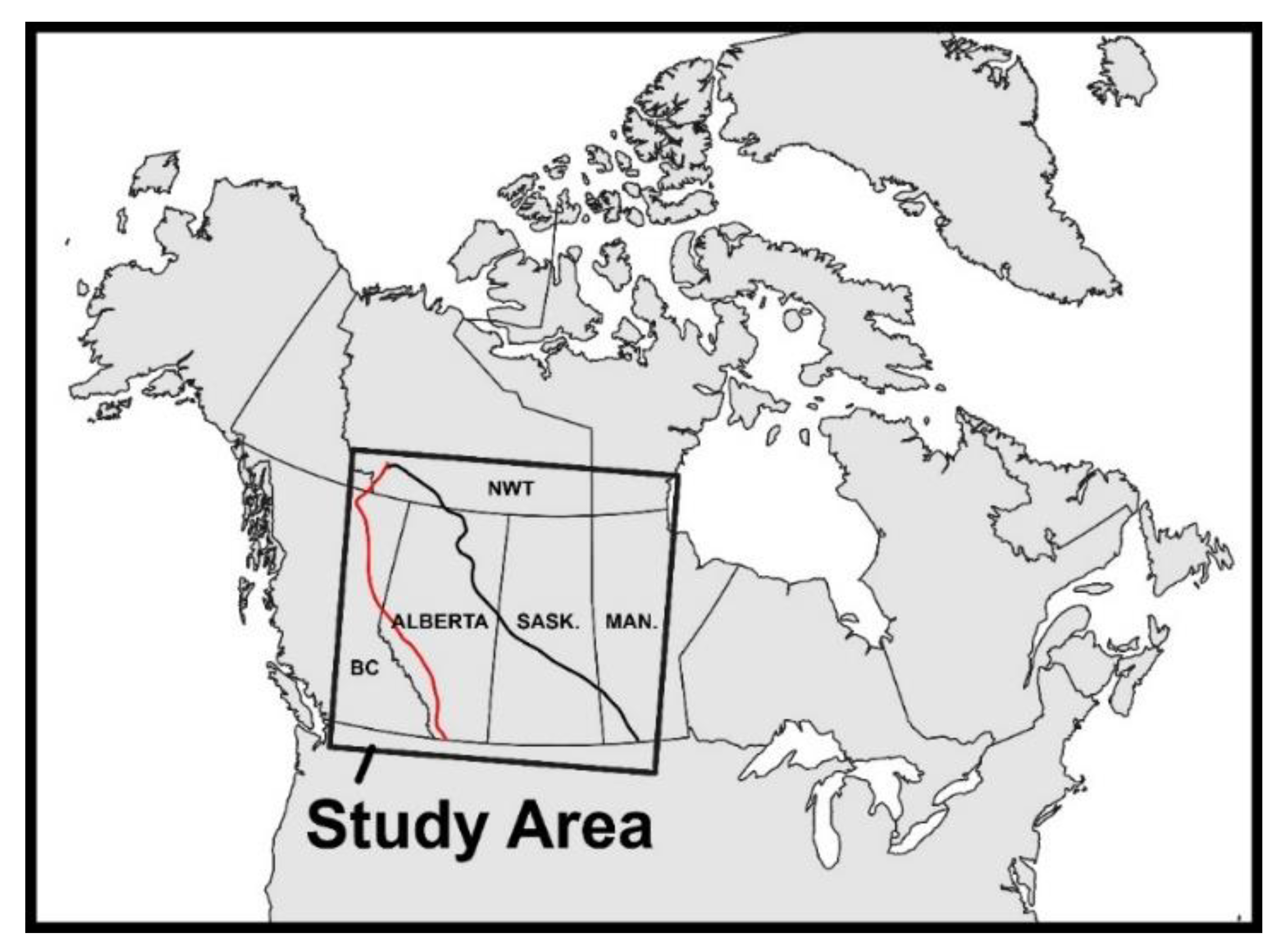
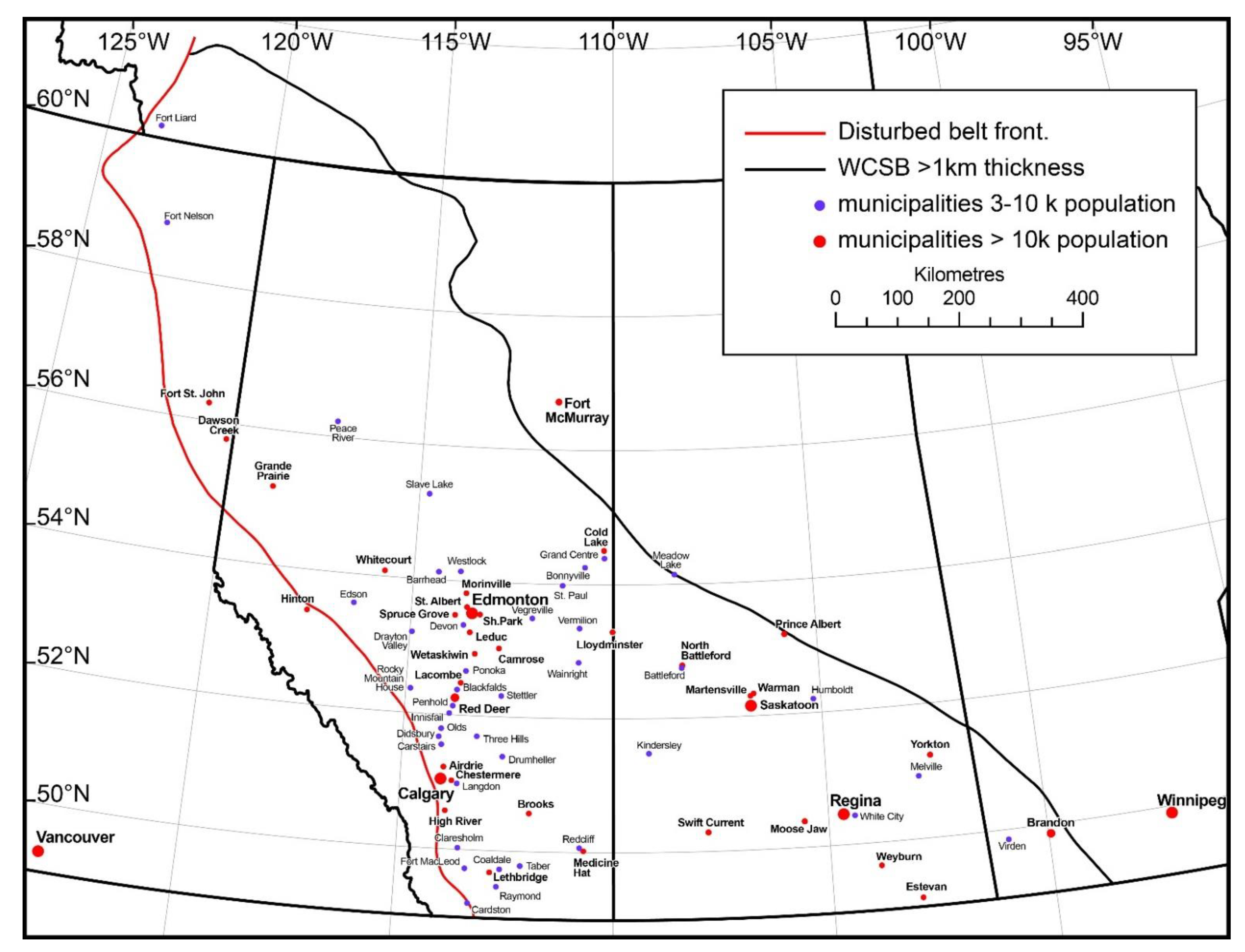
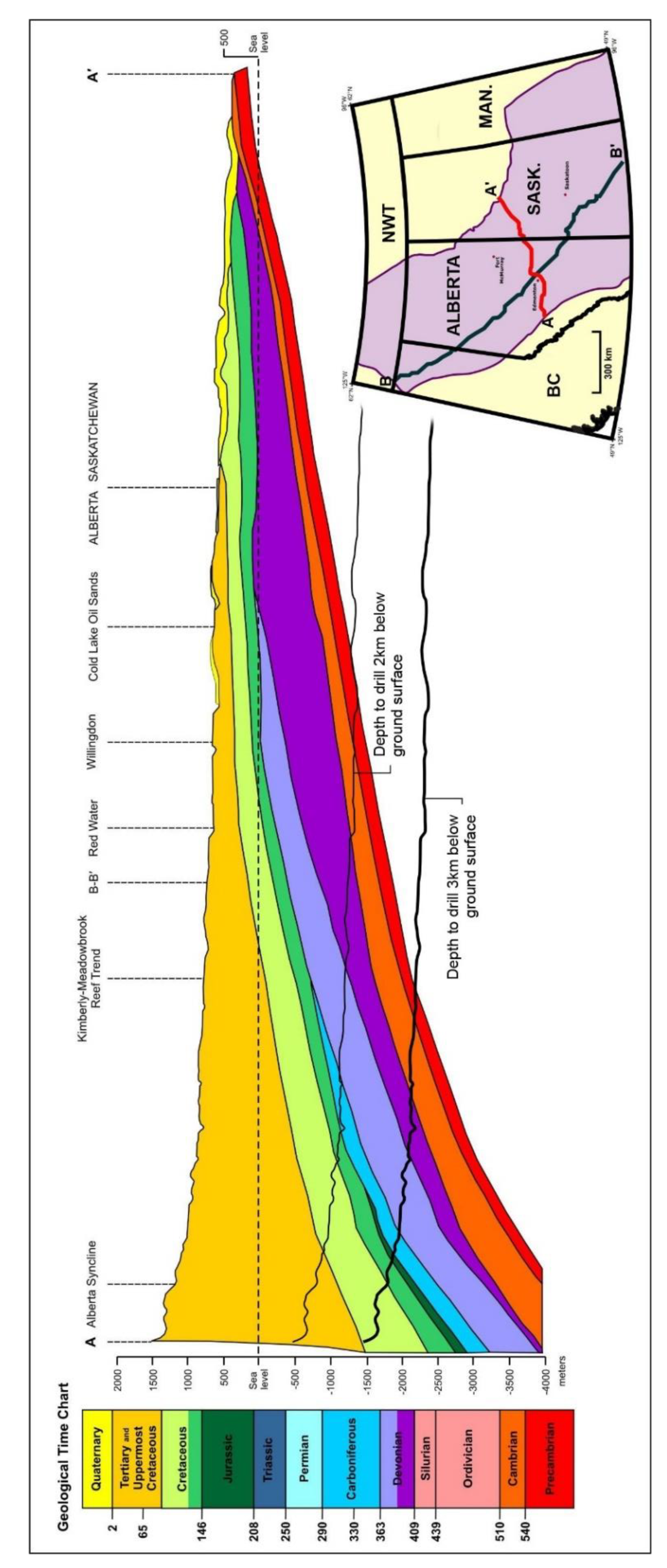
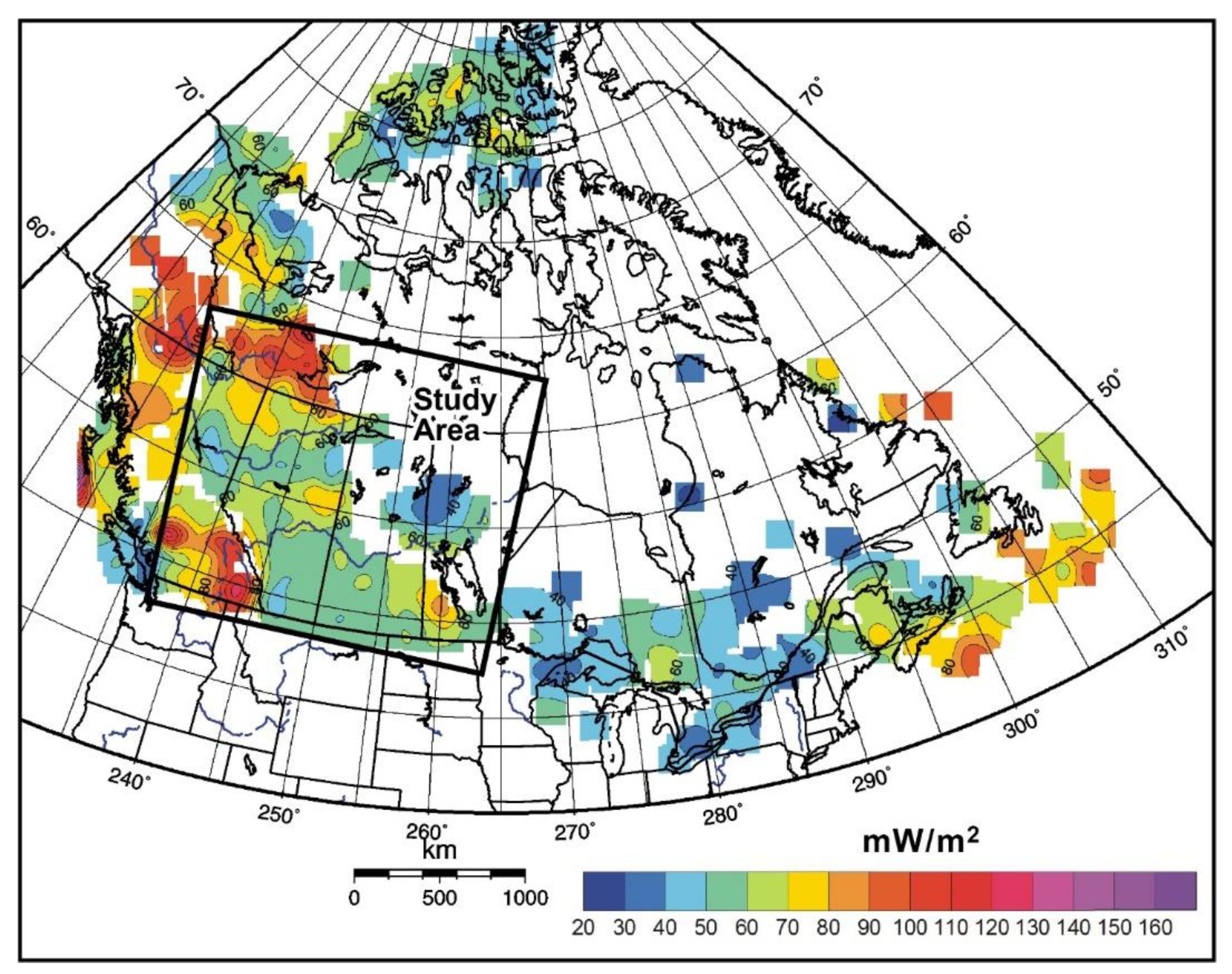
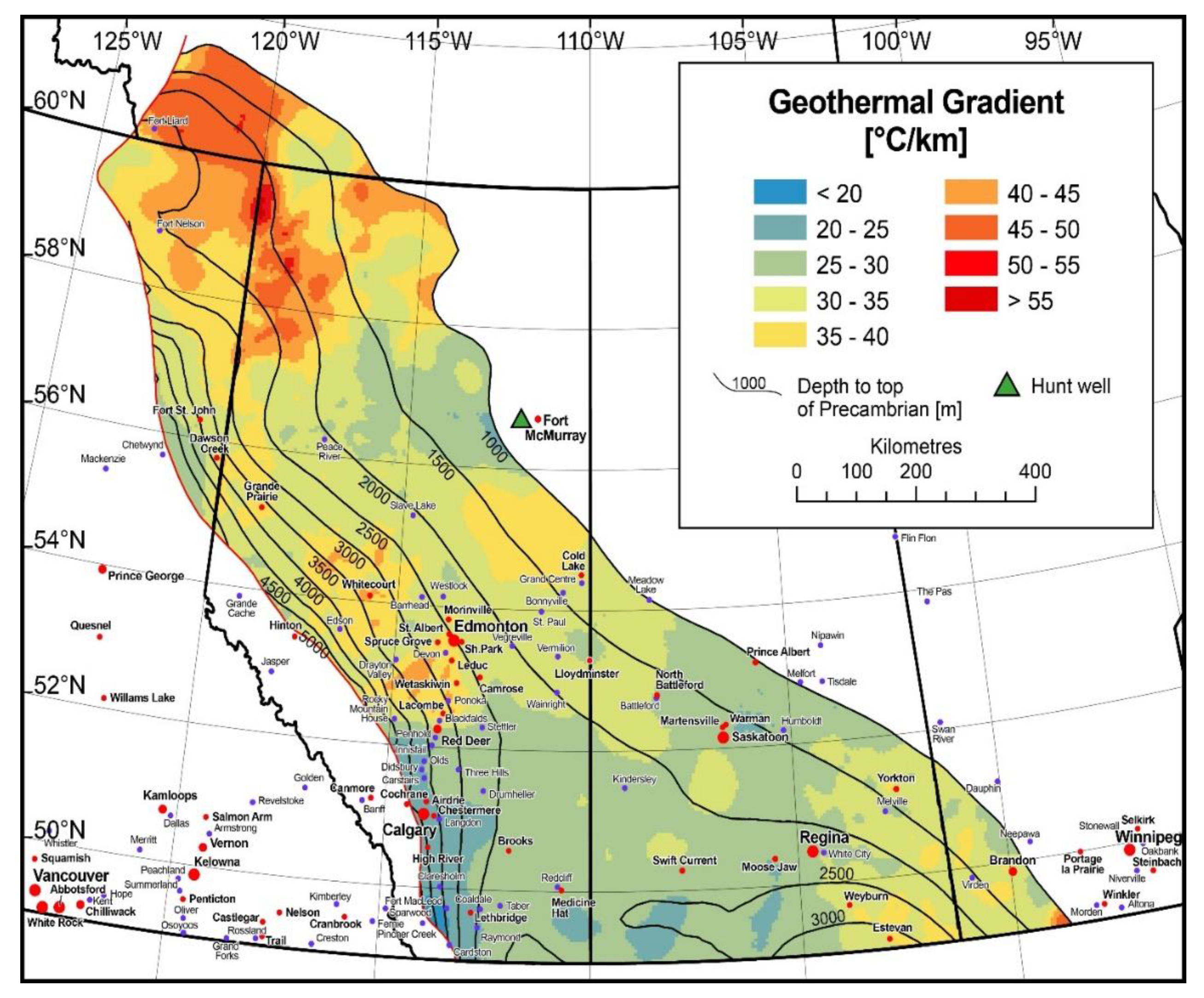
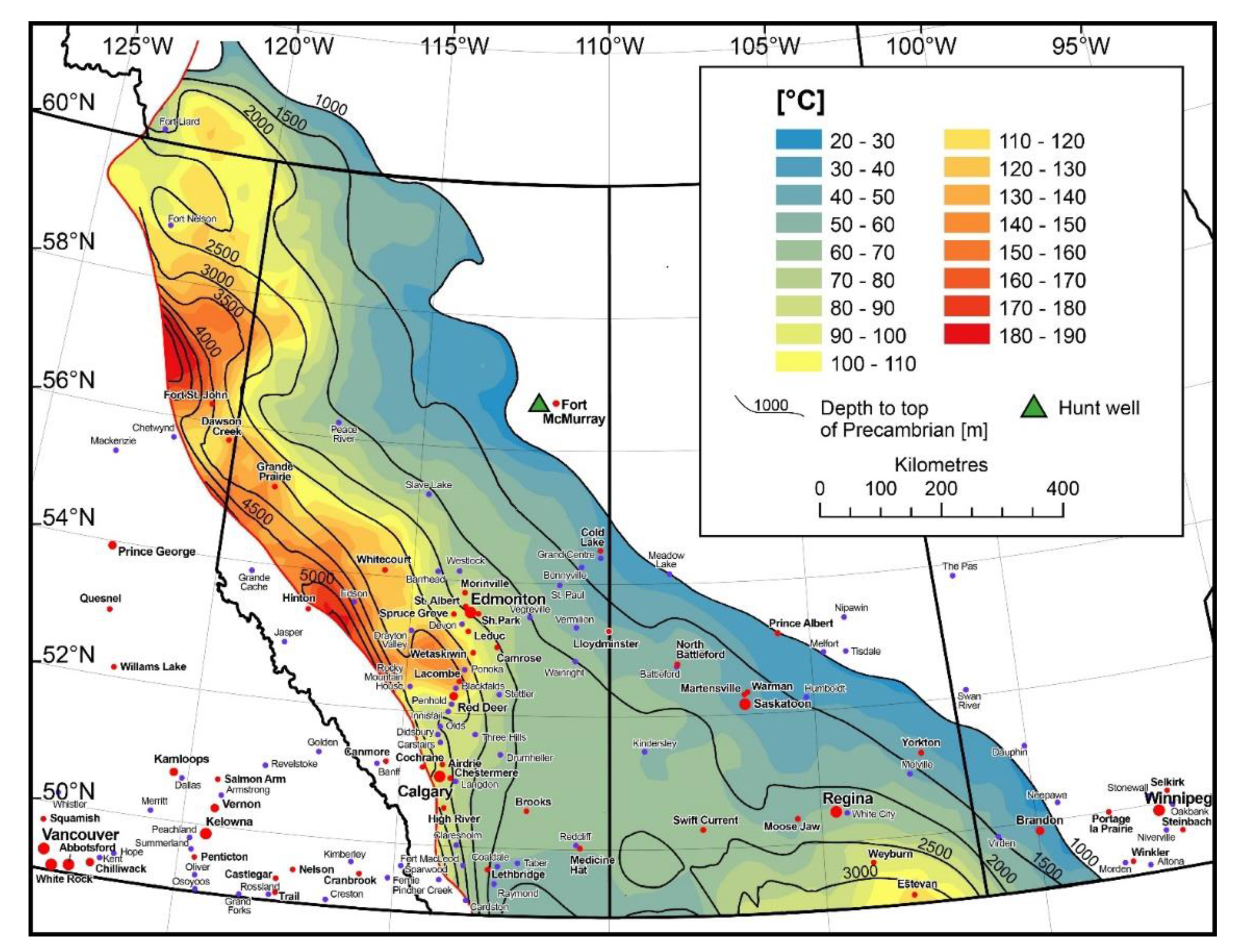
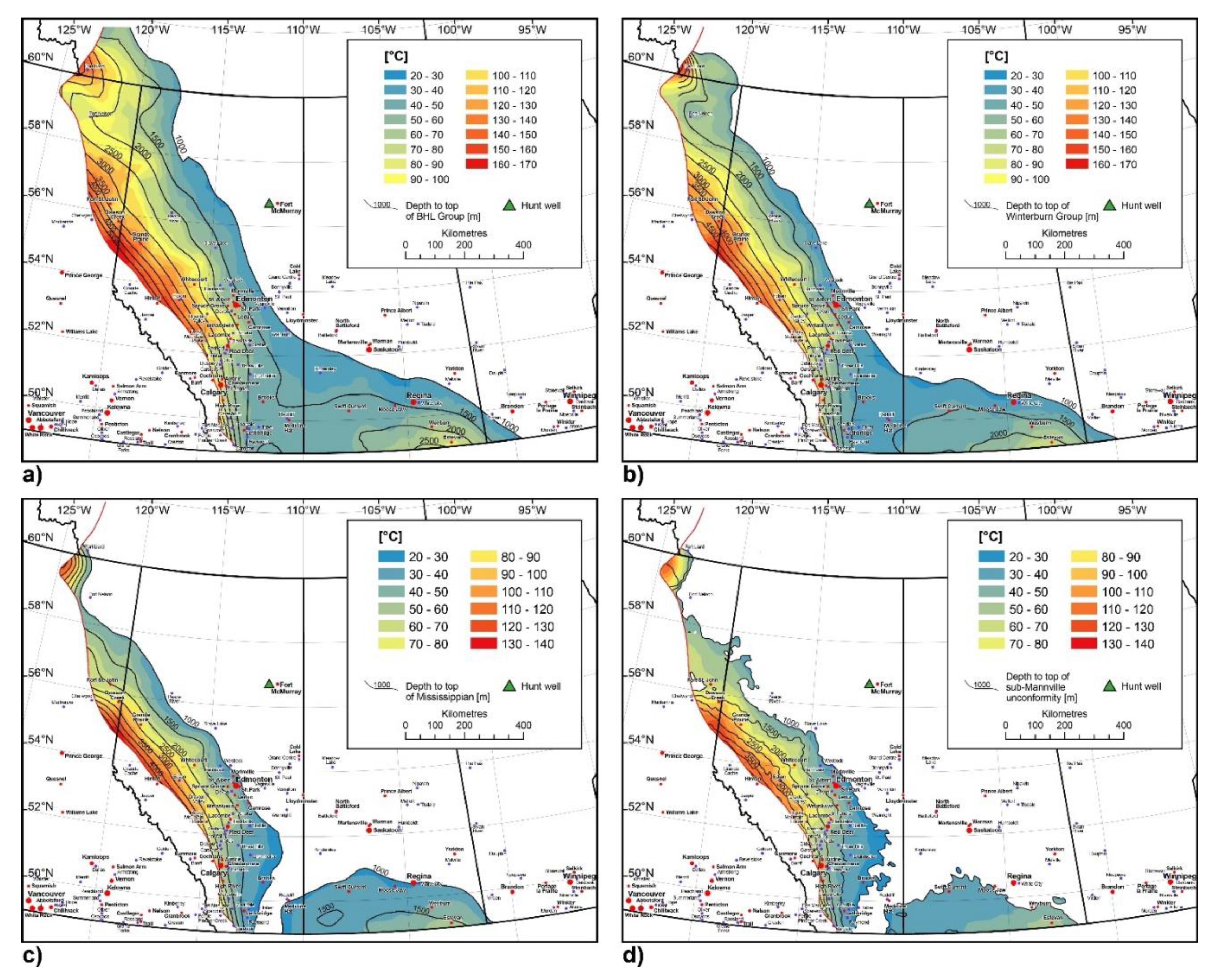

| Period | Group | Formation | Lithology |
|---|---|---|---|
| Cretaceous | Mannville | sandstone | |
| Cretaceous | Mannville | Cadomin | sandst./congl. |
| Mississippian | Rundle | carbonates | |
| Mississippian | - | Charles | carbonates |
| Mississippian | - | Banff | limestone |
| Devonian | Wabamun | Wabamun | dolomite |
| Devonian | Winterburn | Nisku | carbonates |
| Devonian | Woodbend | Grosmont | dolomite |
| Devonian | Woodbend | Leduc | dolomite |
| Devonian | Woodbend | Cooking Lake | carbonates |
| Devonian | Beaverhill | Slave Point | carbonates |
| Devonian | Beaverhill | Swan Hills | carbonates |
| Devonian | Elk Point | Pine Point | dolostone |
| Devonian | - | Granite Wash | sandstone |
| Cambrian | Lynx | Deadwood Fm. | sandstone |
| Cambrian | - | Basal Sandstone | sandstone |
| Parameter | Range | Unit |
|---|---|---|
| Production temperature of geothermal fluid | 70–160 | °C |
| Backflow temperature | 50–60 | °C |
| Specific heat capacity | 3150–3993 | J/kg °C |
| Flow rate | 30–80 | kg/s |
| Conversion MWthermal to MWelectrical factor 1 | 8–12 | % |
Publisher’s Note: MDPI stays neutral with regard to jurisdictional claims in published maps and institutional affiliations. |
© 2021 by the authors. Licensee MDPI, Basel, Switzerland. This article is an open access article distributed under the terms and conditions of the Creative Commons Attribution (CC BY) license (http://creativecommons.org/licenses/by/4.0/).
Share and Cite
Majorowicz, J.; Grasby, S.E. Deep Geothermal Heating Potential for the Communities of the Western Canadian Sedimentary Basin. Energies 2021, 14, 706. https://doi.org/10.3390/en14030706
Majorowicz J, Grasby SE. Deep Geothermal Heating Potential for the Communities of the Western Canadian Sedimentary Basin. Energies. 2021; 14(3):706. https://doi.org/10.3390/en14030706
Chicago/Turabian StyleMajorowicz, Jacek, and Stephen E. Grasby. 2021. "Deep Geothermal Heating Potential for the Communities of the Western Canadian Sedimentary Basin" Energies 14, no. 3: 706. https://doi.org/10.3390/en14030706





